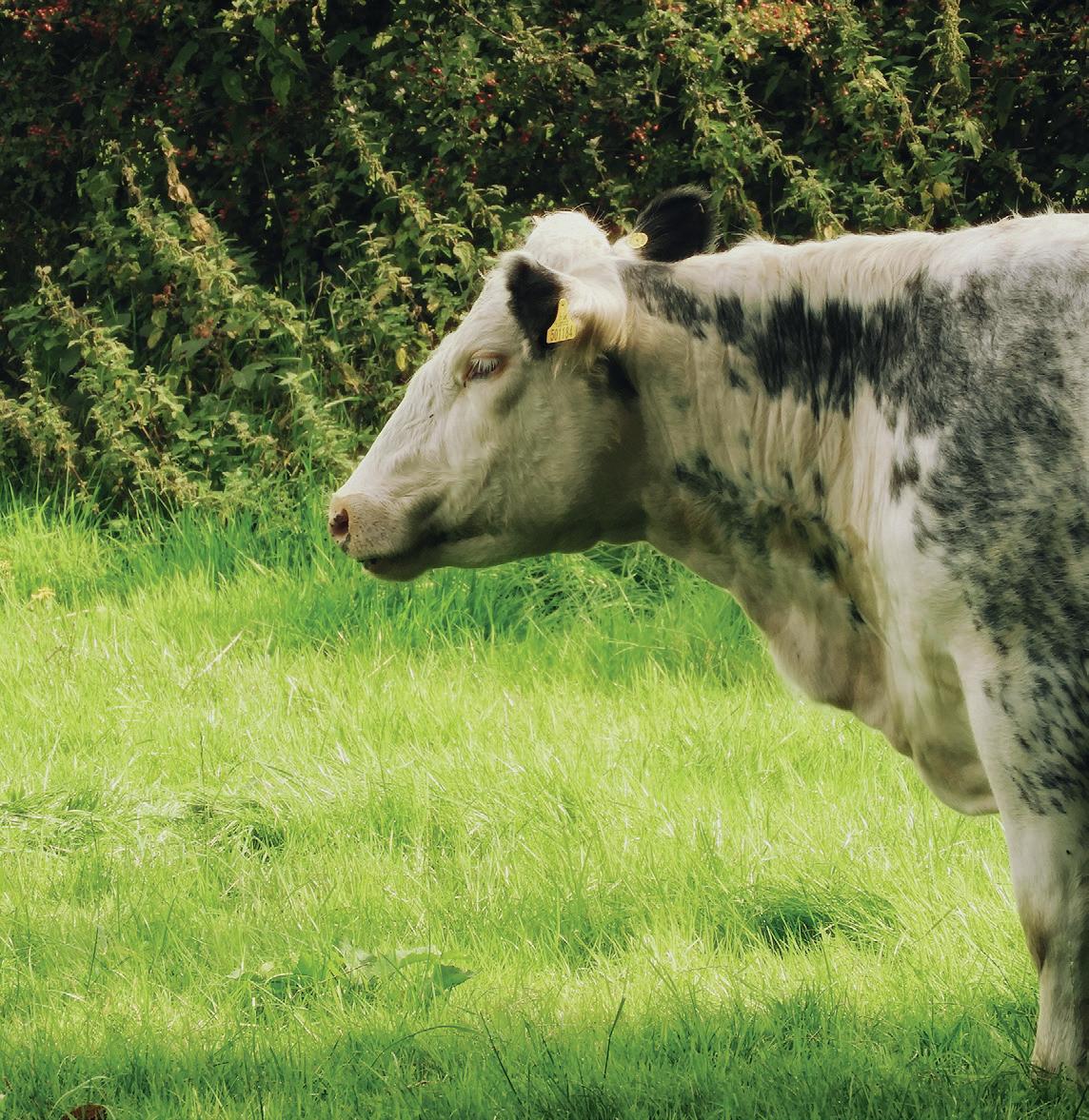



































A SALISBURY man has been appointed as a new Vice Lord-Lieutenant of Wiltshire.
The Lord-Lieutenant of Wiltshire, Sarah Rose Troughton, has appointed Lieutenant General Sir Andrew Gregory KBE CB DL to the role.
It comes following the retirement of William Wyldbore-Smith from the role.
Mrs Troughton said: “I am delighted to welcome Lt Gen Sir Andrew Gregory as the new Vice Lord-Lieutenant and know he will be a huge help to me representing HM The King in our county.

“I also offer my sincere thanks to William WyldboreSmith, who has been a superb and supportive Vice LordLieutenant, always so generous
with his wise counsel and his time.
“I have enjoyed working with him very much indeed.”
Lt Gen Sir Andrew Gregory takes up the role after a long and distinguished military career in the Army.
In 2016, he became the chief executive of SSAFA (Soldiers, Sailors, Airmen and Families
Association), the Armed Forces charity, an organisation that supports serving military personnel, veterans, and their families.
Soon after, he was appointed Master Gunner St James’s Park, the head of the Royal Regiment of Artillery, which has six of its 13 regular units based at Larkhill.
He is governor of a school and a patron of many organisations, including Fighting with Pride, a charity seeking to address the historic wrongs done to LGBT veterans.
He is married with two sons and lives in Salisbury and said he was looking forward to his new role.
“I am extremely honoured to take over from William as the Vice Lord-Lieutenant and will do everything I can to follow the excellent example he has set, to support His Majesty, the Lieutenancy, the LordLieutenant, and the County of Wiltshire,” he said.
To find out more information about the Wiltshire Lieutenancy and its work across the county, log on to lieutenancy.wiltshire. gov.uk.


TWO CONCRETE statues, one of Mickey Mouse and the other of Donald Duck, are among the more unusual repairs that have been undertaken by the Lover Repair Café.
As if that wasn’t enough, these two statues are also the 4,000th repair to be completed by the team at Lover since it started in 2019 – an achievement that is worthy of a celebration.
Lover Repair Café’s team of volunteers will happily take on the repair of most items that are bought in – electrical items, small kitchen appliances, toys, furniture, tools, technical items (such as laptops and tablets), textiles, ceramics, clocks, watches.
If you can carry it in to them; they’ll try and repair it.
A Repair Café is a meeting place where visitors bring their
broken items along for repair. Visitors are encouraged to stay with the repairer so that they learn how to undertake repairs themselves, or they can meet others and enjoy a cup of tea or coffee in a positive, friendly atmosphere.
On average, Lover Repair Café’s volunteers tackle around 80 items a month – and successfully repair almost all of them. This means repaired items are being used for longer and don’t have to be thrown away.
This reduces the waste going to landfill and reduces the volume of raw materials and energy needed to make new products. Both of these, therefore, cut CO2 emissions. It also saves visitors the cost of having to buy new items, while donations from visitors for their
repairs have allowed Lover Repair Café to donate over £22,000 to local charities.
Lover Repair Café is part of the Repair Café Foundation, a global movement of 2,500 cafés in 30 countries, with 35,000 volunteers repairing almost 46,000 items every month.
WORK on a £60 million scheme to create affordable properties for older people in an iconic Salisbury building is soon to be completed.
Construction work to redevelop the Grade II-listed 19th century Finch House is the final phase of development at the former Old Manor Hospital site.

It is being redeveloped by Bournemouthbased developers, Affordable Housing and Healthcare Group (AHH), to provide ‘affordable independent-living properties for over-55s’.
In line with planning and listed building applications approved by Wiltshire Council, work started in 2021 for Finch House to be restored to its original grandeur while being converted into 21 bespoke apartments.

Once finished, the developer says homeowners will benefit from private communal gardens featuring a replacement of the property’s original glasshouse, as well as access to a bistro, activity rooms and other communal facilities shared by the wider Chapters community, operated by Platinum Skies, part of the
AHH company.
While the work is carried out, a listed fountain and sculpture from the front of Finch House is being cared for by specialist restorers, ready to be returned to the driveway once the building and landscaping is complete.
Oliver Hunter, CEO of construction at AHH, said: “Bringing Finch House back to life has been a real labour of love for our construction team.
“They have enjoyed seeing it being restored to its former glory, as a muchtreasured landmark in Salisbury, which deserves to be lived in and loved for many
years to come.
“The homeowners who purchase these apartments are in for a real treat and will be able to own a piece of Salisbury’s history, while having the benefit of being part of our wider over-55s community.”
The construction team is currently working on rendering and painting the external walls of Finch House before the scaffolding is removed.
Inside the building, electrical installation is gradually being rolled out across apartments, before kitchens are fitted and tiling is completed in bathrooms.
Finch House was purchased by William Finch in 1779 before eventually being taken over by his son, Dr William Finch, who also acquired Fisherton House.
The site was later known as The Old Manor, which provided care for mental health patients until the hospital closed in 2003, when Finch House and the neighbouring buildings fell into disrepair.
For more information about the Chapters community development, log on to Platinumskies.co.uk or call 01202 040996.
NOT wearing a seatbelt is among offences being clamped down on by Wiltshire Police this month as part of a special operation.
The Project Zero road safety operation, which targets drivers who fail to abide by the law, is being relaunched this month in a bid to cut the number of casualties on county roads.
It comes just days after Prime Minister Rishi Sunak apologised after being fined by Lancashire Police for not wearing a seatbelt while filming a social media clip.

The PM said he ‘fully accepts this was a mistake and has apologised’ for the offence.
Not belting up is among the offences being highlighted in Wiltshire as part of Project Zero, with a focus on the ‘ Fatal Five’.

They are:
● Excess speed

● Drink/drug driving
● Driving while using a mobile phone
● Not wearing a seatbelt
● Careless/dangerous driving Sgt Ben Cox, of Wiltshire Police, said: “The aim ultimately is to reduce road deaths in our county to zero.
“While this may seem unachievable, I personally can’t think of what would be classed as an ‘acceptable’ number of deaths on the road. One death is one too many.
Nobody likes to think about getting old, but it is certainly worth thinking about if you value your home. That is because your house could very well be sold by the local council to pay for your care fees.
As an example, let’s say you own a home jointly with your partner and you live there until one of you dies. The surviving partner continues to live in the house until they must go into a care home run by the local authority. At that point, the local authority will assess the surviving partner for care fees. If their capital and savings are worth more than £23,250, they will have to fund their own care.
Councils place a charge on the property, which is paid when the house is sold. Alternatively, you may be required to sell the house immediately to raise the cash. Money raised from the sale of the house will fund your care until your savings get down to £23,250. That won’t leave much of an inheritance for your family and loved ones.
There are two solutions to the problem available to you. One is a will trust which protects 50% of the value of your home from care costs. The second is a living trust which shields 100% of the property. Both are relatively inexpensive to put into place. Every trust is administered by trustees, the trustees can be the partners or surviving partner and children.
The situation won’t get better over time. The UK’s fastest-growing age group comprises those aged over 85. Councils will face even more pressure on budgets, leaving them with little choice but to continue to sell people’s homes.
To protect your home, contact Oakwood Wills on 07832 331594
The main thing to remember with trusts is that because you do not own the assets held in the trust in your own name, it is more difficult for those assets to be taken away from you or from the beneficiaries of the trust.
Chris Tennant, Oakwood Wills
“Being the person to inform a family that their loved one has been killed on the roads will always be the hardest part of this job and something that stays with you forever.
“Our aim, every day, is to keep our roads as safe as possible by targeting those who fail to abide by the law. The fatal five are the offences statistically proven to majorly contribute to death and serious injury on the road.
“While this is very much our everyday work on RPU, we will be intensifying our resources for that particular day in a localised area and targeting those most at risk of causing serious harm.”
Project Zero kicked off for 2023 last week when it ran in Amesbury.
In total, seven Traffic Offence Reports were issued and 14 fixed penalty notices –all for Fatal Five-related offences.
AN elderly person with limited mobility was rescued from a property when fire broke out.
Crews from Amesbury and Salisbury were sent to the home after reports of smoke in a kitchen at around 9.30am on Thursday, January 19.
After arriving at the property, in Wittenham View, Amesbury, a Dorset & Wiltshire Fire and Rescue Service spokesperson said one person was rescued.
“The elderly occupant had limited mobility and was not able to leave the property,” they said. “The control firefighter gave fire survival guidance, encouraging the occupier to move towards a door to get fresh air. The first fire crew arrived quickly and assisted the occupier outside into fresh air.”
An item left on the cooker hob caused the blaze and was ‘quickly extinguished’, they added.
THREE LUCKY Stars Appeal supporters have got 2023 off to a great start after scooping the top prizes in the hospital charity’s Christmas raffle.
Nigel Ellis, from Potterne, won the top prize of £1,000 while Richard Langdon, of Barford St Martin, received the second prize of £500.
The £250 third prize went to Maria Francillia from Salisbury. Five others received prizes of £50. The lucky trio were presented with their prizes on 16 January.

Top prize winner Nigel, who is 70-years-old, has supported the charity by taking part in a number of the Star Appeal’s Walk for Wards over the years, was delighted by his raffle win.
He said: “I feel overwhelmed. I support the Stars Appeal because Salisbury Hospital is my hospital.”
On finding out about his raffle windfall, second prize winner, Richard, aged 78, said: “I feel very good about winning. It is the first time I’ve won anything.
I always support the Stars Appeal in various ways.”
Third prize winner, Maria, 42, who is an administration assistant at Salisbury Hospital’s Britford and Downton Wards, added: “It was just a really lovely surprise.”
The Christmas Raffle raised more than £10,000, which will go towards the £1million the Stars Appeal is aiming to raise this year to provide projects that support both patients and staff at Salisbury District Hospital.
Stars Appeal volunteer fundraiser, Jo Maslen, said: “Congratulations to all the winners and a big thank you to everyone who bought tickets and made donations.
“The money raised from the Christmas Raffle will go towards our £1million target to help fund projects that make such a difference to patients, their families and staff at the Hospital.”
The Hospital’s charity is looking to fund a number of projects this year, including a
£142,000 echocardiogram machine for the Cardiac Investigation Unit which will help to reduce waiting times for patients awaiting diagnosis.
It also hopes to raise funds for the following: £55,000 for new scalp cooling machines to help reduce hair loss for cancer patients undergoing chemotherapy on the Pembroke
Unit; a £20,000 brain function monitor for the Neonatal Unit; and a £15,000 mechanical CPR machine.
These are in addition to the ongoing projects the Stars Appeal funds, including support for cancer patients, a 24/7 chaplaincy service, a staff counsellor and free Wi-Fi.
https://starsappeal.org
Hearing loss is often referred to as a hidden disability, with 40% of people over 50 suffering from some deterioration.
Salisbury Community
Lipreading Group is offering sufferers the chance to learn to lip read while making new friends. Why do people learn to lip read, you might ask? For a start, hearing aids are not ideal in crowded situations.

Lip reading can help distinguish missed words.
Because lipreading can help us to better understand what we see and hear, enabling us to take a more active part in conversations.
Lip readers can function better in a hearing world. Those who have a hearing loss may feel very left out when family
and friends are in conversation because they are unable to follow accurately what they say.
Hearing impaired people tend to avoid social situations, which means they risk becoming isolated, depressed and forgotten.
And because microphones and loop systems are not always available or working (shouting is no help, in case you were wondering).
The Alzheimer’s Society informs us that ‘it is common for people to develop gradual hearing loss as they age.
People with hearing loss are also more likely to develop dementia, although at present we don’t know why this is’.
Lip reading can be a lifeline, enabling those with hearing loss
to be more confident and to take an active part in many large and small group situations.
“It is fun to learn. We have a hilarious time analysing our mistakes,” says Linda White, a regular at the Salisbury Community Lipreading Group.
“Hearing loss can bring such isolation and loss of confidence. It is tempting to just hide away.
“The support and tips can be a huge help, but a major reason to come to lip reading is for the companionship with other people in the same boat.”
Beginners classes on Mondays at 11am and on Wednesdays at 9am from the
end of January. Fast track and Advanced sessions are held on the same days.
The sessions are held at St Thomas’ House. There is no fee, simply pay by donation whenever Contact Linda on salisburylipreading@gmail.com for more information.
The group offers companionship and fun
Credit: townpump
A TEMPORARY mortuary has been set up at a salt depot near Salisbury to help cope with an ‘increase in need’.

The facility has been opened at the High Post salt store, which is run by Wiltshire Council as a storage facility for salts used to ‘grit’ the roads in freezing conditions.
But now, a temporary refrigeration unit has been installed on the site, housing people from the city hospital, it is understood.
A spokesperson from the NHS Salisbury Foundation Trust, said: “We can confirm that we have opened additional mortuary capacity to accommodate an increase in need across the local community.

“Our mortuary service operates to the national standards treating the deceased and loved ones with dignity and respect at all times regardless of location.
“All our additional capacity provides privacy and has 24/7 security.”

Wiltshire Council said it was supporting the hospital during a time of ‘extreme pressure’.



Cllr Richard Clewer, council leader, said: “We are supporting our partners at

Salisbury District Hospital during this period of extreme pressure for the NHS.
“The site at High Post is private and is an appropriate location to provide this facility, and it is guarded by security at all times.
“Our staff are specially trained to work in a professional and proper manner, and behave respectfully and sensitively at all times.”
The news comes as data reveals the final weeks of 2022 saw a rise in ‘excess deaths’ in Wiltshire.
Figures from the Office for National Statistics (ONS) show that the weeks ending December 23 and 30 each saw 23 more deaths than ‘expected’ in Wiltshire - a rise of more than 20 percent.

Across the country, more than 650,000 deaths were registered in 2022, a rise of
POLICE have released a CCTV image of a person they would like to trace in connection with the theft and fraudulent use of a bank card.
The image was captured at Tesco Metro, in Salisbury, at around 4pm on January 10.
“We would like to identify this man after a bank card was taken and fraudulently used in a number of shops,” a Wiltshire Police spokesperson said.

The image was taken at Tesco Metro in Salisbury
If you can help, contact police on 101 and quote crime reference number 54230003510.
nine percent on 2019.
It has been reported the extra mortuary at High Post has been in use since January 4.
During the Covid pandemic, extra mortuary space was made available at Salisbury District Hospital.
The NHS Trust has not confirmed if this space has been used again.
COUNCIL tax will rise and rents on social housing increase if a new budget is approved.
Wiltshire Council has released its plan to balance the books amid ‘an unpredictable time’.
The council says the proposed budget - managing £465 million - will deliver ‘quality vital services through an unpredictable time over the next three financial years’ while also ‘delivering on its Business Plan priorities’.
In a bid to balance the books, the council plans to raise council tax by 2.99 percent, in addition to a 2 percent levy to pay for social care.
This increase will be added to demands from the likes of the fire and police services, as well as parish councils and others, to decide final bills.
n What is money being spent on?
A council spokesperson said the proposals would see an increase in council spending in a bid to cover ‘inflation and demand for services’.
The most significant spending in 2023/24, the council says, will be on:
● Whole life pathway (mental health, autism spectrum conditions and learning disabilities support services)
– £96m, an increase of £11m
● Living and aging well (adult care) – £83m, an increase of £15m
● Families and children
–£63m, an increase of £2m
● Environment (which includes waste and recycling services)
– £48m, an increase of £4m
● Highways and transport
– £41m, an increase of £3m
● Education and skills – £29m, an increase of £6m
A funding gap of some £33m will be filled under the plan, the administration says, through a number of savings across council departments, including in staffing, as well as through some increases in charges and taxes.
Some £13 million of reserves will also be released to spend on business priorities under the plans, particularly in supporting housing provision during the cost of living crisis.
n What is happening to council tax and social rents?
Changes to council tax charges would mean an increase in Wiltshire Council’s share of £1.57 per week for those in a Band D property.
Meanwhile, rents on councilowned housing will increase by the maximum allowed – seven percent - meaning the average rent for a two-bedroom home would go from £93.93 per week, to £100.50 per week.
Garage rents will increase by five percent and service charges will also increase to cover costs, the budget proposal says.
Other measures aimed at saving or bringing in money include increasing some fees and charges for services such as leisure and garden waste collection; letting space out at council buildings where appropriate; and a more streamlined Street Scene service.
n Which projects are going ahead?
The council says it will continue to invest in the improvement and maintenance of infrastructure.
Almost £200m is set to be spent on capital projects in 2023/24, including:
● Salisbury Future High Streets – £7.585m
● Trowbridge Future High Streets – £4.403m
● Fitness equipment for leisure centres – £986k
● Council house build programme/refurbishment – £30.580m
● Schools maintenance and modernisation – £8.268m
● Silverwood Special School – £10.262m
● Installation of contactless
parking machines £127k
● Ultrafast broadband –£1.011m
● Structural maintenance and bridges – £20.727m
● M4/J17 project – £1.950m
● A338 Salisbury junction improvements – £1.261m
● A350 Chippenham bypass - £2.640m
● Melksham Bypass – £3.106m
● Trowbridge Leisure Centre – £800k (with further funding for this project allocated in subsequent financial years)
● Drainage improvements – £500k
n What do councillors say about the budget?
Cllr Richard Clewer, leader of Wiltshire Council, pictured above, said: “The factors that are currently affecting everyone in their day-to-day lives, such as huge inflation, energy costs, and the cost-of-living crisis, are what we as a council and organisation are facing, too.

“For a number of years now we have had to overcome eye-watering budget gaps and we believe we have still provided quality services in the face of this.
“Through sound financial management, having a clear Business Plan which drives everything we do, and always favouring the bigger picture over short-term fixes, we believe we are in a much better place than other local
authorities, and that allows us to put forward a balanced budget proposal that sees a financially sustainable council living within its means.
“We don’t make decisions such as proposing an increase to council tax lightly, as we know people are struggling at the moment, but these are necessary choices for us to provide the types of services that people rely on.
“We are also focusing on transforming and modernising our services to adapt to changing demand and new technology, not simply make cuts.
“Despite the challenges, we are still planning a significant uplift in spending on services in our county over the coming years.”
He added: “We continue to be in regular contact with the Government, and they know full well the huge challenges that ourselves and all other local authorities are facing and the vital role we play in the daily lives of residents, so we hope this is recognised in any future funding they allocate.”
Prior to being discussed and debated by councillors, at a Full Council meeting on February 21, the budget proposals will be scrutinised by groups including members, group leaders, trade union representatives and the council’s Overview and Scrutiny Management committee.
Wiltshire Council is also hosting a public webinar on January 25 for people to hear more about the proposals from Cllr Clewer and to have their questions answered.
More information can be found at www.wiltshire.gov.uk/ news/budget-webinar.
To read the budget proposals in full, visit: https://cms.wiltshire.gov.uk/ documents/s210695/ BudgetReport_130123.pdf
SALISBURY households will see an increase in the city council’s share of their council tax bill of almost 44% in a bid to balance the books.
Salisbury City Council approved its budget proposals for 2023/24, including the rise in its share of council tax bills, on Monday (January 16).
The council says it needs to raise a total of more than £5.1 million through council tax in order to continue providing services.
The increase sees the city council’s share of council tax bills rise from £233 last year to £335 - a 43.8% increase - for a Band D property. Bills for Band C properties - the most common in Salisbury - rise from £207.08 to £297.78.
But council chiefs said it was not a ‘fancy budget’ and that cuts had been made in a number of areas in order to balance the books and replenish reserves.
A statement from leaders of the council - Cllr Victoria Charleston, Cllr Ian Tomes and Cllr Annie Riddle - said: “This is not a party political budget. It is a balanced budget. The city council’s reserves cannot be raided. They are already at the minimum level, and must be

rebuilt.
“Like households and businesses everywhere in this economic crisis, we face hugely increased costs.
“Ours include the management of assets such as the Poultry Cross, where insurance will not cover all the repairs found to be needed after last year’s car crash, and upgrading our public toilets and playgrounds.”
Staffing had seen significant increases, they said, including bringing grounds and Street Scene operations back in-house and an average wage increase of 8% for council staff.
“Since our previous budget in January 2022, we’ve had an increase of 223% in our electricity charges, 208% on gas and 50% on water and sewerage,” the leaders said.
“Combined, these take our utility bills over half a million pounds.
“We’ve had a nationally agreed pay rise for staff averaging 8%, with another 4% allowed for in the next financial year.
“Our insurance has more than doubled to £160,000. And we’re facing an unknown rise in business rates in April. We also
have to pay higher employers’ pension contributions – up from 11.1 to 13.7%.”
Only much-needed community services would escape cuts, they added, with some initiatives being cut altogether, or given reduced budgets.
“We are not funding any fancy new projects,” they said. “We are maintaining muchneeded community services such as the Pantry and looking at co-working with a charity to reduce our overheads.
“We have reduced or cut entirely spending on other things which are not our core responsibility, such as city centre security guards, policing of litter louts, and public art.
“We have cut £10,000 from the Neighbourhood Plan
budget, reduced spending on floral displays, ring road cleansing, the Future Salisbury group which promotes the city, and on our Christmas and summer events budget (down 10%).
“We have repeatedly invited the Conservatives to share in the council’s joint administration but they say they prefer to be in opposition.
“Nonetheless, we invited them to join us in preparing this budget. They didn’t even reply.”
The budget came as Wiltshire Council announced it planned to increase its council tax demand, as well as social rents, in its budget proposals. (https://salisburyandavon.co.uk/ news/council-tax-and-socialrents-to-rise-under-wiltshirebudget-proposals/)
IT’S the time of year when headlinesalmost daily - inform us of a rise in council tax for the coming year.
In April, we will all start paying a new rate of tax.
At the moment, councils are putting together their figures for how much that bill will be when it reaches us.
But it’s not as simple as many of us imagine.
Why do we see so many headlines about a rise in council tax?
Well, the council tax bill that falls on to our mats for the year is the outcome of a series of steps.
Our bill is made up a number of ‘precepts’ - requests from different organisations - that are put together to make up a final payable amount.
For example, on these pages, we detail the setting of ‘precepts’ by two organisations - Wiltshire Council and Salisbury City Council (SCC).
Wiltshire Council’s precept will be on all bills across the county, while the SCC precept will be part of a bill for households in that authority’s area. Areas not covered by SCC will have a precept from their respective parish or town council.
But it doesn’t end there. The final bill
will also include precepts requested by the Police and Crime Commissioner (PCC) for policing, as well as from the Wiltshire Fire Authority, to provide fire services.
In total then, your council tax bill is calculated once precepts from Wiltshire Council, fire, police and your city/town/ parish council have been finalised and put together. For example, a household in Salisbury city centre will get a bill made up of precepts from Wiltshire Council, the fire authority, PCC and Salisbury City Council.
That’s why it can be a bit confusing and difficult to arrive at an actual figure on how much you will be paying.
THE death of an Amesbury man – which saw five people arrested after a murder probe was launched - has been deemed ‘not suspicious’.
Kiran Pun’s body was found in an area of shrubbery in Aldershot, Hampshire, on the afternoon of January 15.

He had been missing since December 1, last year, having travelled to the town from Andover, via Farnborough.
Following a post mortem, Hampshire Police said officers investigating his disappearance have determined his death was not suspicious.
The 36-year-old’s family has been informed and continue to be supported by specialist officers. A file will be prepared for the coroner.
Five people arrested on suspicion of murder as part of our enquiries to locate Kiran have now been released with no further action taken.
DCI Adam Edwards, head of the major crime department at Hampshire and Isle of Wight Constabulary, said: “Our thoughts are with Kiran’s family at this very difficult time.
“Our team has worked tirelessly to try and piece together Kiran’s movements, locate him and provide his family with the answers they have been seeking about what happened to him.
“As part of our enquiries, we did make arrests on suspicion of murder, which was done on the basis of the information available to us and to enable us to conduct a full and thorough investigation into what had taken place.
“I want to thank everyone who has come forward with information throughout our enquiries.”
Chief Inspector Emma Hart, District Commander for Hart and Rushmoor, added: “I know
Kiran’s disappearance has been of considerable concern and my thoughts are with his family, friends and the community at this time.
“I want to extend my thanks to all who have shared information with us throughout our investigation to help us piece together Kiran’s
movements and support us as we worked to locate him.
“All information submitted to us has been reviewed and shared with my local teams, and enables us to build up a picture of what is happening in the community and informs our patrol and policing plans for the district.”
PLANS to convert a city centre shop into a three-bedroom house have been submitted.
The premises, in Winchester Street, were formally used as a salon, with residential accommodation to the rear and on the first and second floors.
The new application, on behalf of a
Mr O’Keefe, would see a change of use of the building to a residential property. “The proposed change of use would provide a kitchen, living space, WC and ancillary office on the ground floor with three bedrooms across the first and second floor.
“The shop front is to be altered, nonoriginal windows to rear to be removed and new rooflights added.
For more details, and to comment on the application, visit wiltshire.gov.uk and search for application reference PL/2023/00264
WINTERSLOW Youth Zone is back thanks to a grant and support from Wiltshire Council’s Rural Youth Outreach Project.
The club has been closed for more than three years because of a lack of available volunteers.
However, following regular support and expert input from youth officers funded through the area board Rural Youth Outreach Project grant during
2022, including the recruiting of a new set of village volunteers all keen to run sessions from early 2023, the club can now once again meet the needs of local children.
The Rural Youth Outreach Project plan now is to refocus efforts on other parishes in the area to ensure more young people currently not engaged in positive activities can take advantage of new opportunities on their doorstep.

A KIOSK at a Salisbury park is up for grabs – and businesses are being urged to come forward with their ideas.
Salisbury City Council is offering a unique opportunity for firms to apply for a concession in the purpose-built kiosk at Victoria Park. The contract is for three years, starting on April 1, 2023.
The kiosk is a fully-contained building with everything you need to run a food/drink offering for Salisbury’s park going public; electricity, water supply, and a serving hatch, along with convenient counter tops and storage.
“The previous tenant was given permission for a seating area and to construct a covered seating area which can again be arranged with further discussion,” a council spokesperson said. “Victoria Park is a popular area five minutes north of the city centre that contains a playground, tennis club, and hosts numerous activities and groups throughout the year.”

The concession fee is £6,000 per year, plus electricity costs. Contact Luke via lharris@salisburycitycouncil.gov.uk.






HAVE YOU RECENTLY HAD A CARDIAC EVENT? HAPPY HEARTS CARDIAC EXERCISE AND SUPPORT CAN HELP WITH YOUR RECOVERY
OUR NEXT CARDIAC REHABILITATION (PHASE III) RECOVERY PROGRAMME WILL BE RUNNING FROM: TUESDAY 31st JANUARY 2.00pm to 4.30pm: AT SOUTH NEWTON VILLAGE HALL SALISBURY SP2 OPJ.

OUR PROGRAMMES ARE RUN BY MEDICAL CLINICIANS, A QUALIFIED CARDIAC EXERCISE PRACTITIONER AND BHF VOLUNTEER SPEAKERS. PERSONAL SMALL FRIENDLY GROUPS: THIS 6 WEEK REHABILITATION WILL INCLUDE EXERCISE, EDUCATIONAL AND INFORMATIVE TALKS AND A HEALTHY AFTERNOON TEA.
IF YOU HAVE BEEN DISCHARGED FROM HOSPITAL AND NEED TO GET YOURSELF ON THE ROAD TO RECOVERY, WE ARE HERE TO HELP YOU. WHETHER ITS TO GET BACK TO WORK, ENJOY YOUR RETIREMENT, OR SIMPLY WANT MORE UNDERSTANDING OF YOUR HEART CONDITION AND REGAIN YOUR SELF CONFIDENCE.
FOR ALL DETAILS AND A FULL PROGRAMME CONTENT PLEASE VISIT OUR WEBSITE AND CLICK ON THE LINK
www.sallishappyhearts.co.uk
Or call Salli 07969909162
Email: info@sallishappyhearts.co.uk

WILTSHIRE COUNCIL is advising residents in areas at risk of groundwater flooding – particularly in the south of the county – to be prepared as water levels continue to rise.
There have been flooding incidents in Wilton and Britford recently, and groundwater levels in the Salisbury Plain and Cranborne Chase areas are currently high. Although the weather is forecast to be mostly dry during the coming days, people should be prepared in case of groundwater flooding.
The council recommends that residents should ensure they are best prepared by signing up for Environment Agency flood alerts and by being ready to act in case of a warning.

Cllr Caroline Thomas, cabinet member for flooding,
said: “Groundwater in the south of the county is currently at high levels, and there are some Environment Agency flood warnings and alerts currently in place, so people should be prepared.
“Of course, this can change quickly and so people should sign up for Environment Agency flood warnings for up-to-date information, and know what to do in case of groundwater flooding.
The weather forecast looks set to be drier in the foreseeable future, but with both rivers and groundwater levels high around the county, any further rainfall will increase the risk of flooding, so it is essential that people are prepared.
The council is working closely with the Environment
The growing demands of the digital age come with pitfalls. Cybercrime and fraud can have a devastating impact, both financially and emotionally, on victims’ lives.
In January 2022 The Blue Lamp Trust launched the Cyber Bobby scheme to help older people, those with disabilities or who have been a victim of cyber crime, to stay safe online.
The service is unique because it offers home visits from volunteer cyber advisors who will give advice and guidance about basic IT security and how to avoid being affected by a cyber crime or a cyber enabled crime to the elderly and disabled in Hampshire.
The areas covered during a visit include: What is cyber crime? Cyber and scam prevention advice; How to check privacy settings Signposting to other advice and resources; How to report issues; How to recognise scam emails and text messages.
In the first year of the scheme the Cyber Bobby team visited 76 residents in Hampshire – 88% of these were aged 60 and over and 23% of referrals were for people who had already been a victim of cyber crime.
Collectively, the volunteer Cyber Advisors donated over 135 hours of their time, visiting residents and giving talks to community groups. Anyone can make an online referral for someone they know who may benefit from a visit. If you organise a community group in Hampshire and would like a Cyber Bobby Advisor to come and give a talk people can get in touch via cyber@bluelamptrust.org.uk
Agency and water companies to help reduce the potential impacts of flooding. It also works with town and parish councils through its network of flood wardens to ensure
Wiltshire Council has warned that more flooding events are likely
communities are as resilient as possible and to help them prepare effectively.
FROM MONDAY, 6th March to Thursday, 23rd March, Wiltshire Council will be temporarily closing a part of Stonehenge Road, Amesbury, for all traffic.
The closure will run from its junction with C42 for a distance of approximately 40 metres in a north-westerly direction. The diversion route will be clearly indicated by traffic signs.
For further information, contact Wiltshire Council on 0300 456 0105, or visit https://one.network/?tm=130828998
THE EVER-POPULAR Godshill quiz night returns on the 10 February. Teams of six are needed. There will be a variety of questions with the double-act of two quiz mistresses, in charge of the evening.
The £12 ticket price, includes a hot, home-cooked supper. Tickets are available from Marlene Williams on 01425 650845 and Alison Ayling on 01425 650770 or 07798 555500.
For further details contact Derek Ayling, publicity, on Hippotrain@BTInternet.com
HOW MUCH waste can you save in a month? Wiltshire Wildlife Trust is calling on the county’s residents to take up the #WasteFreeFeb challenge, which last year saw over 400 people save six tonnes of rubbish from going into their waste bins.
The aim of the challenge, now in its sixth year, is to try to get people to look at the rubbish they are producing and see what they can do to limit it, by reducing, reusing, recycling and composting more.
It is estimated that UK households throw away 1.85 billion pieces of plastic packaging a week and 4.5 million tonnes of edible food is thrown away every year.
There are huge positive environmental impacts to producing less waste, including a reduction in resources being used as raw
materials, less waste sent to landfill and incineration, and local councils being able to spend more on public services instead of paying so much landfill tax.
Alongside these, there are also financial benefits to reducing food and water waste, as well as energy usage.
By reducing your waste this February, you can learn to live a sustainable lifestyle, reduce your impact on the planet and save some pennies.
Eleanor Dodson, digital marketing and communications officer at Wiltshire Wildlife Trust, said: “This year, more than ever, people are feeling the pinch from the cost-of-living crisis. By taking part in Waste Free Feb, you can learn how to make the most of what you have at home and save those pennies in the process.
“A sustainable life is an affordable one, and it helps the environment, too.”
Making small changes can make a big impact. If watching your waste for a whole month isn’t possible, try it for a day, or a week or two.
People taking part are encouraged to set their own challenge with an achievable goal and time frame for reducing waste, with previous participants choosing to throw away no more than one carrier bag’s worth of waste over a week and others aiming to throw away less than a black bag’s worth over the whole of February.
Some enthusiastic participants have even managed to fill no more than a jam jar for the month. However much they reduce, people taking part in the challenge are encouraged to share photos, videos and stories about their efforts, to encourage others to join them in reducing their waste throughout February and beyond.
There will also be an opportunity for fundraisers by getting friends and family to sponsor participants for their waste-saving efforts.
All participants who sign up online will receive a weekly email with hints and tips on:
● How to reduce food waste, including the benefits of community fridges and a guest blog from FoodCycle Swindon

● How to reduce plastic waste, such as single-use plastic, including a guest blog from local business 10 Green Bottles
● How to reduce textiles waste, e.g. by reusing old clothes

● How to use energy more efficiently at home to reduce utility bills and stay warm this winter
A key focus in the campaign’s first week will be on the emergence of community fridges across the county and their benefits. There are now over 10 community fridges in Wiltshire, which particularly benefit those who are struggling financially.
Community fridges are spaces where anyone can access free, quality food that would otherwise go to waste, learn about the environmental impact of food, and share food skills and knowledge with others in the community.
There are two in the Salisbury area, one at St Michaels Church and Community Centre on St Michael’s Road, just off Castle Road and the other, Old Sarum and Longehedge, on Beatrice Road.
The Trust has created a useful map of local shops and businesses that offer waste-free shopping in Wiltshire, including local community fridges, and has a downloadable guide available on their Waste Free Feb page online to give people advice and tips.
Take on the challenge! Sign up for Waste Free Feb and get some inspiration at: https://www.wiltshirewildlife.org/wastefree-february
Words and photo by Tristan Ovington CHILDREN often spawn adult creativity and Lizi Sayer, the 38-year-old owner of children’s clothing brand The Hidden Flamingo certainly taps into this with the aesthetic of her products.
“I make handmade children’s clothes and accessories from birth to seven years,” Lizi explains. “I try to create clothes inspired by children and the natural world, so I like to put animal faces and animal prints on them as this is what children are usually interested in.
“I was a secondary school performing arts teacher for 10 years. I struggled with work life balance when I tried to continue teaching after I had my second child in 2013 and left teaching following the Christmas of 2016. I started making textile themed gifts like cushions and purses, while children’s clothes came much later in the summer 2017 when I started making some simple summer dresses for my six-year-old daughter, Imogen.
“Another motivating factor that got me into kids clothing is that I felt they should

have a genuine choice in clothing, because commercial boys and girls clothing is very stereotyped. My daughter loves blue and my son loves pink clothes. And another example of how boys and girls don’t fit stereotypes is that recently I made some unicorn style dungarees out of the same material I used for a girl’s dress for a boy who loved unicorns. I try to make clothing that suits the individual child and their individual tastes.”
But the road to becoming a popular clothing brand is paved with challenges. “One of the biggest challenges is figuring everything out from scratch. I had no previous business experience, so working out social media marketing and photography was hard, but I worked at it and I have come a long way in both.
“My biggest success is creating a new business from scratch when before I was a teacher and a mum. I am proud to still attend assemblies and parents evenings while generating an income as part of a flexible working life/family balance. To me, success is not about how much money you
have. It’s about having a rounded experience of life with family, an income and some time to yourself to look after your own mental health.
“With my clothing brand The Hidden Flamingo I have struck the perfect balance, so I would encourage others to start their own business too.”
www.thehiddenflamingo.com/
LAW FIRM, Trethowans has appointed a new partner to its private client team.
Kathryn Anderson, who has a wealth of experience in private client work, having almost 20 years’ experience in the field, has successfully supported a variety of clients, including private individuals and charities.
In her new role, Kathryn will work with individuals on wills, lifetime planning and estate administration, collaborating with Trethowans’ other teams, such as residential, agriculture and commercial property.

Kathryn said: “I’m looking forward to supporting clients of Trethowans and building on the existing relationships I have in the charity sector.

The private client team has links with lots of local people, from doctors to financial advisors, so there’s plenty of variety.
“I’m a Salisbury local and all my family are here, so it means a lot to me to help this community.”
Mike Watson, managing partner at Trethowans, said: “We are delighted to welcome Kathryn to Trethowans.
Her considerable experience and contacts in the Salisbury community will make her an asset to our growing private client team.”
Trethowans was recently named as one of The Times Best Law Firms for 2023 – the newspaper’s annual report of the top 200 legal practices in England and Wales.
The firm was also recognised in the latest Legal 500, achieving top tier status in the renowned legal directory for services in Personal Tax, Trusts & Probate, Corporate and Commercial, Licensing and Personal Injury & Clinical Negligence (claimant).
UNPLEASANT smells can lead to life-changing ideas according to Leanne Ford, 33, owner of English Rose which makes diffusers, bath salts and skin balms.
“We love our dog but don’t love the doggy smell,” explains Leanne. “To combat the odour we were spending a lot of money on diffusers, air fresheners and candles, so we found that using essential oils to make our own products was more effective and cheaper.
“When friends came to visit they were always struck by how nice it smelled and so I decided to open a business selling these products.”
Leanne continues. “I use all natural products to create reed diffusers, skin balms, bath salts and massage oils. I avoid
synthetic products to make them healthier.
“I also put dried petals in the container for the reed diffusers which make them more aesthetically pleasing and unique as gifts.
“When I was thinking of a name for the business, I thought of my nan’s pretty name, Rose. This is a theme for my products, which are all named after my family, like the Rose and Geranium aroma which is called Marlie after my daughter.”
Leanne considers the challenges she overcame to get where she is today. “The biggest challenge is that customers like variety, meaning new products. This makes it difficult for testing as you need to ensure products are safe while keeping new products coming in quickly.
“The amount of time to do this can vary, because I have to make it at home and try it with my family. For example, the winter balm took two years to get sales-ready.”
But the positive feedback makes it all worthwhile. “I
recently did a craft fair and a lady’s son suffered sinus problems and had trouble sleeping. But after using my Winter Balm decongestant, which contains eucalyptus, lemon, peppermint, and rosemary, she told me he had the best night sleep he’d ever had.
“Often, people tell me that my products are much better than far more expensive brands, which I love to hear as it saves people money and helps my business grow.
On what of her future plans?
“I want to bring out a new diffuser set, more aimed at men, with woody aromas like cedar wood and other scents. I love what I do and it’s always exciting to bring new products into my range.”
Insta: @english_rose_ fragrance, Facebook: @ EnglishRoseFragrance
WORKING with glass represented a way out of a stressful career in education for Helen Southwell, founder and owner of The Glass Room.
“I was a teacher for 20 years and after that I worked in school improvement and ended up being head of school improvement for South Wiltshire. I was highly stressed in this role and I was doing glass as a hobby at the time.
“My mother had Alzheimers and often became a risk to herself in the middle of the night and when my husband suggested I retired early, in 2021, I agreed and have never looked back since.”
So how did it all begin? “I began to sell on Etsy and became part of Plain Arts Salisbury,” explains Helen. “I’ve exhibited in
Gallery 4 in the Salisbury Library, at Langford Lakes, and at a pop up exhibition in one of the empty units in The Guild.
“Glass skills came after I moved to our current house in 2000 because it had a beautiful stained glass front door surround but the actual door contained plain glass.
“I immediately wanted to replace the plain glass window to match the stained glass surround so I learnt how to do it myself and it all progressed from there.
“I am most proud of my larger projects in schools. For St Paul’s 50th anniversary, 50 children made fused glass fish which had the appearance of swimming around a skylight.

“And at St Martins 70th anniversary, everyone including staff, the governor and every child made a fused glass tile which were all combined into a
large window in their reception area. When the sun shines through it looks stunning and it’s something everyone in the school can be proud of.
For those considering starting a small business but unsure where to start, Helen has some advice. “Set yourself
smart, achievable targets to propel yourself constantly forward. Get friends and family involved and generate an online presence as soon as possible.
“Don’t sit and wait for it to happen for you, act now to realise your dreams.”
www.theglassroom.uk


RECENTLY (on January 19), councils discovered that wealthy areas, including the prime minister’s Richmond constituency (receiving £19m), will benefit from the new £2.1bn pot of funding, while many deprived areas will miss out.
The lack of focus and strategy is evident in the approval of a worthy, but somewhat bizarre, range of projects. A new seafront for Cleethorpes, an “obesity project” for Farnborough, an “AI campus” for Blackpool, a Brexit relief road for Dover, and more.
Widespread discontent with the process and the outcome of the allocation of funding was expressed by council leaders and MPs across the country. Conservative mayor of the West Midlands Andy Street, decried the government’s “begging bowl culture” and said he had pressed ministers for answers on why some of the region’s poorest areas had lost out.

Shadow Levelling Up Secretary Lisa Nandy said: “The levelling up fund is in chaos, beset by delays and allegations of favouritism.” Nandy argued that the announcement is the “equivalent of handing us a fiver and nicking 20 quid out of our back pocket…” referring to the money recently stripped out of community budgets for vital services such as child care, bus services and social care.
Levelling up first reared its head during the election campaign of 2019. It took until February 2022 before Levelling Up Secretary Michael Gove attempted to provide a strategic direction for the funding. His ‘12 missions’ amounted to vague promises without specific targets.
Gove said it would “shift both money and power into the hands of working people”.
But Andy Street clearly feels Gove’s strategy has not been successful, stating: “The centralised system of London civil servants making local decisions is flawed and I cannot understand why the levelling up funding money was not devolved for local decision-makers to decide on what is best for their areas…”
What we have seen this week is the prime minister jetting up north to demonstrate his commitment to ‘levelling up’ by enthusiastically reminding us he was actually visiting Accrington, Morecambe and the North East.
Sunak was quick to point out a higher proportion (per person) of the £2.1bn funding was allocated to the north of England. To put that in perspective, the Treasury has committed £5bn a year to the HS2 railway project which primarily serves the home counties, cancelled the east-west rail link between Leeds and Manchester, while London celebrates the opening of the £19bn Elizabeth underground line.
According to the government, allocation of funding is not only determined by deprivation, but takes into account value for money, deliverability, and whether the project fits with the priorities of the levelling up fund. This broad range of factors have had major implications for funding allocations and understandably led to accusations, from regional leaders, of the government offering “pre-election bribes”
It is worth noting that vulnerable Conservative marginal seats, those with majorities of fewer than 8,000 votes, have received 1.5 times the amount of funding per person than all other constituencies.
LAST week, I spent a night in Salisbury District Hospital with my baby, who was struggling to breathe due to a chest infection.
On the previous Tuesday I had spoken to the pharmacist and the GP about him. Then, on Thursday I spoke to the health visitor and the GP in person. By Monday his condition had not improved, and the GP advised taking him straight to A&E, where we were seen by a succession of brilliant, empathetic nurses, doctors and consultants.
I will be forever grateful for their care of my baby.
All week long I was worrying about my son, who seemed to be getting worse, while simultaneously worrying about burdening our NHS. Our NHS which, according to the chief executive of NHS
England, Amanda Pritchard, is under the greatest strain ever.

One thing I did not worry about, however, was the cost of getting the necessary care and treatment to get my baby well.
Former Health Minister Sajid Javid has said it seems reasonable to charge the European standard of £20 for a GP appointment and the Irish model of a ‘nominal’ £66 charge for a visit to A&E.
According to The Guardian, Javid said, ‘“extending the contributory principle” should be part of radical reforms to tackle growing waiting times.’
Under this scheme, getting my baby the care he needed could have cost at least £126
this week. An amount of money many would find difficult to find a week before pay day, driving further inequality in health outcomes, as those with the least would find it harder to justify seeking medical attention. And once we extend the contributory principle to GP visits and A&E, how long before I am paying for the overnight stay, the oxygen mask, the neonatal monitor (of which we had to use three)?
If we want to start a grown
up conversation, let’s examine how much of the NHS is currently propped up by the private sector. Taxpayer money used to outsource beds and procedures the NHS just can’t cope with. Let’s discuss the sharp decline in the number of hospital beds, at the same time as we’re dealing with an aging population. According to the Kings Fund, the number of hospital beds has more than halved in the last 30 years.
Or let’s discuss social care. 38% of Wiltshire Council’s budget will be spent on social care next year and yet the system is on its knees.
We do need a grown up conversation about the NHS, but it should not start with the introduction of a two-tier health system: those who can afford and those who cannot.
‘It is time for conversation on NHS’Victoria Charleston Lib Dems Parliamentary Spokesperson for Salisbury Constituency
THE POSSIBILITY of a bat infected with rabies passing the disease onto humans or other mammals is rare, according to an updated report by Defra.


However, a number of infected bats have been identified in the south west over the past few years, including in Somerset and Dorset (the Poole area in particular), and it is important to know how to spot potential cases and what your responsibilities are.
Rabies in bats is a notifiable animal disease. If you suspect you have identified a case, you must report it immediately by calling the Defra Rural Services Helpline on 03000 200 301.
Note, that failure to do so is an offence.
How do you know a bat has rabies?
It can be hard to spot signs of infection and it can only be confirmed in a laboratory.
There are clinical signs that a bat may be carrying rabies: they are prone to be more aggressive, they may appear disorientated and have difficulty flying, which may lead to injury.
Slightly harder to spot is that the eyes may take on a staring expression.
How is rabies spread by bats?
A bite from an infected bat can
pass on rabies as it is present in saliva.
Perhaps even less pleasantly, if saliva from an infected bat gets into an open wound or comes into contact with the nostrils, mouth and lips, eyelids and ears, it is possible to pass on the disease.
As stated above, it is possible for a human to catch rabies from an infected bat, but the rarity of the disease makes this unlikely.
If you do have cause for thinking you might have come into contact with the saliva of an infected bat you will need to seek emergency medical help.
There are vaccinations against rabies, and the disease can normally be prevented if you are treated soon after exposure.
However, once signs of rabies appear, there is no treatment and past human cases have been fatal.
Human symptoms include:
● Anxiety, headaches and fever in the early stages.
● Spasms of the swallowing muscles, making it difficult or impossible to drink.
● Breathing difficulties.
If you regularly handle bats you should ensure you are vaccinated against the disease.
If you do need to handle bats, Defra offers the following advice:
● Assume that all bats are possible carriers of rabies.
● Avoid touching bats, living or dead, whenever possible.
● If you must touch a bat, follow the Bat Conservation Trust guidance and wear thick gloves to avoid being bitten or scratched.
If you have been bitten or scratched by a bat, or exposed to bat saliva or nervous tissue in any other way, you must:
● Wash the wound or contact area with soap and water.
● Disinfect the wound.
● Contact a doctor immediately, who will decide whether you need treatment.
If you suspect rabies or you see abnormal behaviour in a bat, contact the Animal and Plant Health Agency (APHA) via the Defra number and following directions to be put through.
APHA vets will investigate and may submit the bat for
testing to see whether the signs were caused by rabies.
If you find a dead bat
Do not directly handle the bat if possible. If you have to touch the bat, follow the Bat Conservation Trust guidance (see below) and use thick gloves.
If your pet catches a bat, keep your pet under observation. If your pet falls sick or starts behaving unusually, you must contact your vet immediately. Your vet will tell APHA if they suspect your pet has rabies.
APHA tests dead bats submitted by the public to monitor how widespread the disease is in Great Britain.
Only very few have tested positive in more than 15,000 tests since 1986, so the risk of catching rabies from a bat is very low.
But it is always best to be prepared and to be alert.
https://www.bats.org.uk/ resources/guidance-forprofessionals
TODAY, Valentine’s Day is all flowers, kisses and chocolate, but it wasn’t always like that. Most likely originating in ancient Rome, the 3rd century rituals surrounding the ‘Lupercalia’ celebrations were far from romantic.
Lupercalia was a festival that took place in the middle of February, marking the official start of spring time. It involved some brutal practices, as well as some matchmaking.
But who was Valentine? Popular belief suggests that Emperor Claudius II (also known as Claudius Gothica) banned marriage because he thought married men were bad soldiers – he was proclaimed Emperor by his troops after leading a number of military campaigns.
Valentine, a young priest, was outraged about this injustice and withstood Claudius by blessing marriages for lovers in secret. Valentine’s actions were soon discovered and Emperor Claudius sentenced him to death.
During his time in prison, he fell in love with the warden’s daughter. When Valentine was taken to be killed on 14th February, 270 AD, he sent the young lady a love letter, signed “from your Valentine”.
His martyrdom was honoured by the Catholic Church with the celebration of St Valentine’s Day, in an effort to expel the pagan ritual.
As the centuries went on, the holiday became more romantic. Chaucer and Shakespeare romanticised it in their work and it gained popularity throughout Europe and Britain. Notes on handmade paper cards became all the rage in the Middle Ages.
With the industrial revolution in the 19th century, mass produced cards became widely available. February has not been the same since.
Some interesting facts:
● France’s Duke of Orléans sent the first known Valentine’s card to his wife in 1415
● King Henry VII of England officially declared St Valentine’s Day a holiday in 1537
● In the late 1800s, Richard Cadbury introduced the first box of chocolates
● 64% of people who buy Valentine’s Day flowers are men
● Over 25 million cards are sent for Valentine’s Day each year
● Approximately 110 million roses (typically red) are sold and delivered in a three-day period around Valentine’s Day But why do we give flowers on Valentine’s Day? Sending flowers became a commonly used way for lovers and admirers to express secret messages. Sharing their feelings openly would have been unacceptable in Victorian times. The meaning behind each flower, i.e. what they meant to say, was often pulled from various myths, fables or legends.
Giving flowers on Valentine’s Day is still a romantic gesture for couples all over the world.
Flowers are a simple, yet thoughtful gift that symbolizes your love for another person.
Like every florist, our team at Milston Flower Barn is incredibly busy just before and on Valentine’s Day. Bouquet after bouquet leaves our premises to celebrate love.
However, with the seemingly endless choices available, it can be a bit overwhelming when February 14th comes around. From a single stem to an extravagant floral arrangement, there are plenty of styles, colours and designs to choose from.
Here are some tips from our experienced ‘Team Cupid’:
For many, red roses are the ‘go-to’ option on Valentine’s day. That doesn’t come as a surprise, as the beautiful rose was said to be the favourite flower of Venus, the Roman goddess of love.

However, with our British climate, long-stemmed roses are not grown in this country and are flown thousands of miles in refrigerated containers.
Most roses come from Kenya, where it is warm enough for them to grow naturally, or the Netherlands, where they are grown under artificial light.
According to the Guardian, “around eight million stems are imported... alone during February – about three times as many as any other month”, creating a massive carbon footprint.
However, there are more ethical and sustainable options to choose from. Renowned for their bulb heads and curving leaves, tulips are the most prevalent of all garden flowers, easily available from local British growers.
A bouquet of bright tulips is a great option for those wishing to give a gift that’s sustainable, but that still says, ‘I love you’.
Other beautiful varieties grown locally are hellebores, narcissi, hyacinths, snowdrops and cyclamen. While snowdrops symbolise purity and renewal, cyclamen are known as the plant of lasting feelings and sincere affection – a perfect combination for Valentine’s Day.
Another great alternative to roses are dried flowers. At this time of the year some beauties like hydrangeas, strawflowers and nigella are readily available. Totally sustainable and utterly en vogue.
Happy Valentine’s Day from Milston Flower Barn.




















GREEN FINGERED volunteers wanted to join the team at a sustainably focused community garden in the Cathedral Close in Salisbury.
A new community garden has been created in a quiet corner of Arundells, a historic house which was the home of former Prime Minister Sir Edward Heath.
The garden, which is part of a National Lottery Heritage funded community programme, brings back to life the former walled kitchen garden, an overgrown space that once saw flourishing vegetable patches and fruit bushes.

A team of military veterans from Alabaré’s ‘Boots on the Ground’ project, led by Rebecca Twigg of Kingdom of Sticks, have worked tirelessly to create a haven for nature and wildlife, complete with raised beds, a greenhouse, bespoke forged benches, and a pond.
It complements the formal grounds at Arundells and is a tranquil, sheltered space to enjoy nature and gardening.
Thanks to further funding, the gardening project is expanding. “We are keen to hear from anyone who has a gardening and wildlife interest and who can become one of our new volunteers from March 2023,” said Rebecca.
“The garden will not have the usual ‘drop in’ style that
some other community gardens have, because we have to limit numbers due to the size and layout of the gated garden site.”
Volunteers will be invited to get involved in a new Wednesday group, set up in partnership with the Activity Alliance’s Get Out Get Active (GOGA) programme.
This inclusive group will enable people with a wide range of access needs to garden together. It will open as soon as the works on an accessible pathway and wet weather shelter have been completed. A variety of raised planters were provided by Salisbury’s Men’s Shed last summer, making the gardening activities comfortable for all.

“The ethos of the garden is sustainable, wildlife friendly and very much about slow gardening, mindfulness and being outside in the fresh air,” explained Rebecca.
“So while you do need to have an interest in organic gardens, nature and wildlife, it is also going to be a good place to be for someone who would simply like to find new community connections, and a peaceful place to sit and watch the world go by.”
Arundells is a historic house located within the beautiful Cathedral Close, owned and managed by the Sir Edward Heath Charitable Foundation. The community garden is part of
an exciting programme of funded activities which welcome local people to enjoy everything Arundells has to offer.
To find out more about being a volunteer, please contact
Top: Before the programme; Above: The garden at the start of the year
Credit: Rebecca Twigg
FEBRUARY is very much a month of preparing, planting and pruning. Although spring might still feel some way off, now is the time for a gardening spring clean.
Start with your greenhouse and move on to pots and cloches. Make sure gutters are clear of leaves and glass panes are letting maximum sunlight
through to your plants inside. Clean your cloches with warm, soapy water before rinsing thoroughly with water. It always pays to get these things done before you need them.
Check any labels are still in good health and legible, if not, think about replacing them.
In the comfort of a shed, conservatory or greenhouse, take
a good look at all of your garden tools. Replace or repair any that need attention before spring transforms your garden. Check your lawn mower as well.
Prune any fruit trees you have not got round to yet. Now is a good time to prune back buddleias. They can take a decent prune and will benefit from being tamed a little to ensure more
flowers later in the year.
You can begin warming soil ahead of spring planting. Once you have dug the soil over, cover with organic matter, incorporating it nearer to spring, and cover with plastic sheeting or fleece.
You can apply a thick mulch around perennial plants, trees, shrubs, and fruit. Be careful not to cover dwarf bulbs.

FARMERS and those working in the agricultural industries will have the chance to tell the government of the main challenges they face when it comes to trade in the postBrexit landscape thanks to a consultation launched by the UK Trade and Business Commission.

Since launching in April 2021, the UK Trade and Business Commission has scrutinised the UK government’s new trade agreements and their impact on the UK economy, businesses and people.
Having found that postBrexit trade agreements have not delivered significant benefits for UK businesses, improvements to living
standards or opportunities for the UK public, the UK Trade and Business Commission is developing a blueprint for how the UK should be negotiating trade deals to boost economic growth and deliver a better future for the UK.
The commission is seeking opinions from a number of sectors, including farming and agriculture. The post-Brexit UK economy has shrunk, with GDP as much as 5.5% lower than before the split with the European Union.
The number of seasonal workers that many industries rely is estimated to have fallen by 330,000.
Submissions from the farming sector will be used to inform the UK Trade and Business Commission’s blueprint for how modern trade should be carried out for the benefit of the UK economy, businesses and the public.

To submit evidence and take part in the consultation, visit the consultation portal via https://
www.tradeandbusiness.uk/ consultation. The deadline for submitting evidence is 23:59 on Friday, 17th March, but participants are being encouraged to submit as early as possible to give the commissioners time to consider all of the evidence.
Hilary Benn MP, coconvener of the UK Trade and Business Commission, said: “This consultation will enable the day-to-day experience of British firms to influence proposals for a new trading relationship. We are looking not only for answers to immediate problems but also ideas for future trade agreements which can create opportunities for both established and new British export businesses.”
Wiltshire Wildlife Trust calls for greater support for farmers to increase food security and meet the UK’s nature recovery targets
THE UK’S food security and its dependence on nature and a stable climate was in the spotlight at this month’s farming conferences.
The Oxford farming conferences followed closely after the UN biodiversity summit in Montreal, Canada (COP15) at the end of last year.
At COP15, the UK signed up to the international agreement to protect 30% of land and sea for nature by 2030.
A 50% reduction in the risk from harmful chemicals by 2030 was also agreed.
As custodians of more than 70% of the UK countryside, and 80% of land in Wiltshire, farmers will play a crucial part in achieving these targets.
But the Wiltshire Wildlife Trust is calling on the UK Government to urgently provide the support needed by farmers to embrace sustainable and regenerative farming approaches and to break the cycle of using pesticides and fertilizers.

Wiltshire Wildlife Trust’s CEO, Gary Mantle, attended the Oxford Real Farming Conference at the beginning of January, which connects people in the UK who want to transform the food and farming system: “The
atmosphere at the conference was very encouraging. It is clear that an agro-ecological approach to farming is becoming much more mainstream, and I was really encouraged by the number of young people coming into farming.
“It was inspiring to hear how more farmers are looking for creative ways to respond to the nature and climate crisis.
“There were many examples of farmers restoring nature on their land and capturing more carbon whilst still producing good quality food.
“From creating hedgerows and planting trees to introducing flower-rich grass areas on the edge of fields, nature-friendly farming is already happening across the country, but more support is needed to make landscape scale change.”
The mood amongst delegates was a mixture of hope and frustration against the backdrop of recent government announcements on the postBrexit Environmental Land Management (ELM) schemes intended to support farmers.
At the Oxford Farming Conference on 5 January, farming minister Mark Spencer announced:
● Additional payments for farmers of up to £1,000 a year to cover the administration costs of entering the most accessible Sustainable Farming Incentive of ELMs


● An additional increase of around 10% for those already engaged in the Countryside Stewardship scheme, which has shown positive but limited benefits to nature over its various iterations since 1991
● An increase by an average of 48% in capital payment rates, which cover one-off projects such as hedgerow creation.
Gary Mantle added: “While it is encouraging that the government is engaging with the farming community and recognising the crucial part farmers can play in nature’s recovery, the agri support payments announced are nowhere near enough to meet the UK’s commitments to protect 30% of land for nature and halve the risk from harmful chemicals.
“A scheme which was meant to be simpler, with less paperwork for farmers, now requires £1,000 to cover administrative costs, which will reduce the money to spend on actual enhancements.
“And with no increase in the overall budget for environmental improvement on
farmland, we are concerned that these cash incentives will be to the detriment of more ambitious landscape scale projects crucial to nature’s recovery – and to sustainable food production.
“We want to see more support for farmers to enable them to transition to an Integrated Pest Management system with less reliance on harmful chemicals such as pesticides and artificial fertilisers.
“With appropriate support, Integrated Pest Management could become the mainstream approach. This would be very good news for butterflies, bees and other invertebrates which have decreased dramatically in recent years.
“We are concerned about the slow progress and the continued lack of clarity for farmers wishing to take part. We look forward to hearing more details from the government soon and hope for an increase in the investment in these schemes, which is needed to meet the country’s nature recovery targets.”
The NFU has issued advice for farmers who have been adversely affected by flooding.
Step 1 – Report and record
You should report flooding incidents to the Environment Agency incident hotline by calling 0800 80 70 60.
Remember to keep a record of what you report, and when.
You should also start to gather evidence including videos, pictures and flooding impacts on your farm.
Take photos of everything that has been damaged by flood water to support any claims you might make. Even low value items can amount to considerable sums when added together.
Trying to evidence loss after an event can be difficult.
Step 2 – Understand the impact on schemes and services
Defra has produced advice for farmers and land managers whose land has been impacted by flooding.
The guidance covers government services (TB testing, animal movement), agrienvironment and woodland schemes.
NFU members concerned about the impact of flooding on schemes and services agreements should read this guidance to understand what course of action to take.

If you think the flooding will affect your ability to meet your agri-environment scheme agreement, you should read the guidance and, if needed, contact the Rural Payment Agency as soon as reasonably practicable.
If you have concerns about the impact of flooding on a scheme such as the England Woodland Creation Offer (EWCO) that is administered by the Forestry Commission rather than by the Rural Payments Agency, you should read the
guidance and if needed contact the Forestry Commission directly.
Step 3 – Ensure you are aware of other considerations
EA advice: Slurry spreading in wet conditions
You can contact the Environment Agency to discuss options if your store is at risk of causing pollution and you cannot avoid spreading when you think there is a risk of slurry runoff, run-through to land drains or leaching, or you will breach an NVZ condition.
Remember your responsibilities if you are a riparian owner. Check the NFU’s Water Maintenance Solutions guidance pack for more information.
Report any issues with main rivers to the EA; issues with ordinary watercourses should be reported to an Internal Drainage Board (if in a drainage district), or to the local authority.
It is important to consider your own safety, and that of others, before carrying out any work during or after a flood.
Consider risks from further high tides or high river flows before you start any work by
checking flood warnings, river levels and the five-day flood risk.
If you are clearing up after flooding or undertaking repairs in or near watercourses, then please contact EA for advice on 03708 506 506.
The EA can help to ensure that you can undertake the necessary works to recover from flooding, using emergency provisions where possible. It will do this provided it is safe for you to do the work and the work doesn’t cause any greater risk of flooding.
Download the EA’s advice on what to do after a flood: Flood recovery advice for the agricultural sector
Our long-term asks from government is that farmers who are intentionally flooded in order to protect people and property are performing a public good and should therefore be reimbursed for the public good being provided.
The NFU is therefore asking for:
● A review of the Flood Defence Grant in Aid cost-benefit analysis so that it
sufficiently values agricultural land.
● The EA to prioritise essential maintenance of flood defence assets and watercourses. Whilst current funding prioritises concentrations of people and property, farmers experience a lack of maintenance of watercourses and coastal channels and reduced maintenance of banks and flood defence assets. The result is more frequent, more extensive and longer duration flooding events.
● The EA to improve communications on flood risk: systems for communicating with those affected must be accurate and reach the most remote communities, providing sufficient time for response.
The NFU believes that an integrated water management strategy should be developed. One that gives farmers and growers a central role in:
● The better management of land to improve water quality.
● The better management of water to tackle the dual challenges of floods and droughts.
While enabling them to keep feeding the nation.
3
4 Ignoramus (5)
5 Green skill (7)
6 Opening (5)
7 Female sheep (3)
12 The process of coming into prominence (9)
14 Distinguished (7)
15 Maternity-ward baby (7)
17 Evict (5)
18 Seizes (5)
21 Workout muscles (3)
Place 1 to 9 once into every black-bordered 3x3 area as well as each of the 54 rows indicated by the coloured lines. Rows don’t
Across
Across
1 Frozen block? Reserve one, say (3,4)
5 Couple feature in news bulletin (4)
9 Mistake allowed for one of three? (7)
10 Examine minutely soft gown (5)
11 Fool dropped wee bacon sandwiches (5)
Down
1 Frozen block? Reserve one, say (3,4)
5 Couple feature in news bulletin (4)
2 Agree with sound of clock? (5)
9 Mistake allowed for one of three? (7)
3 Star given allowance for festive treat? (11)
10 Examine minutely soft gown (5)
4 Intensely cold alcoholic drink (6)
11 Fool dropped wee bacon sandwiches (5)
6 Consideration still close to respect (7)
12 Provoke anger with someone ultimately? (6)
7 Humble writer on English king (4)
12 Provoke anger with someone ultimately? (6)
14 Type of gear regardless of time relating to a cell (6)
14 Type of gear regardless of time relating to a cell (6)
16 Fortified place the French set behind shed (6)
8 Act that’s orchestrated around Delaware one in college, say (7)
18 I show dishonesty in married university setting (6)
16 Fortified place the French set behind shed (6)
18 I show dishonesty in married university setting (6)
19 Drive that is engaging politician on left (5)
22 Deride society with hackneyed material (5)
23 Event of music and dance excited child touring Ireland (not half) (7)
24 Remainder in the back (4)
Across
1 Frozen block? Reserve one, say (3,4)
5 Couple feature in news bulletin (4)
9 Mistake allowed for one of three? (7)
10 Examine minutely soft gown (5)
11 Fool dropped wee bacon sandwiches (5)
10 A top trilby I misrepresented as having characteristic of light headwear? (11)
19 Drive that is engaging politician on left (5)
22 Deride society with hackneyed material (5)
13 Sound chalet first off dismantled on sides highway (7)
23 Event of music and dance excited child touring Ireland (not half) (7)
24 Remainder in the back (4)
15 Academic institution with class that’s regular (7)
25 Act green and use two-wheeled transport again (7)
25 Act green and use two-wheeled transport again (7)
12 Provoke anger with someone ultimately? (6)
14 Type of gear regardless of time relating to a cell (6)
16 Fortified place the French set behind shed (6)
18 I show dishonesty in married university setting (6)
19 Drive that is engaging politician on left (5)
22 Deride society with hackneyed material (5)
23 Event of music and dance excited child touring Ireland (not half) (7)
24 Remainder in the back (4)
Place 1 to 9 once each into every row, column and boldlined 3x3 box. No digit maybe repeated in any dashed-lined cage, and each dash-lined cage must result in the given value when the stated operation is applied between all of the digits in that cage. For subtraction and division operations, start with the highest number in the cage and then subtract or divide by the other numbers in that cage
25 Act green and use two-wheeled transport again (7)
17 Strength in sea food, it’s said (6)
20 Small bottle? China imports hard one (5)
21 Government authority confused irritated expression (4)
Down
2 Agree with sound of clock? (5)
3 Star given allowance for festive treat? (11)
4 Intensely cold alcoholic drink (6)
6 Consideration still close to respect (7)
7 Humble writer on English king (4)
8 Act that’s orchestrated around Delaware for one in college, say (7)
10
A top trilby I misrepresented as having characteristic of light headwear? (11)
13 Sound chalet first off dismantled on sides of highway (7)
15 Academic institution with class that’s regular (7)
17 Strength in sea food, it’s said (6)
20 Small bottle? China imports hard one (5)
21 Government authority confused irritated expression (4)
For the solutions, turn to page
THIS YEAR’S candlelit Epiphany Devotion, celebrating the journey of the Magi to worship the infant Jesus, looked more glorious than ever thanks to changes in where the choir and orchestra were placed.

The third of three processional services, the Epiphany Devotion follows on from Advent and Christmas and in the past the choir and orchestra were placed by the font.
However, space is limited in that part of the Cathedral and so this year they performed from the West End, against the backdrop of the Cathedral’s magnificent Christmas tree and West End balcony window. This change in choreography left the nave free for the arrival of the ‘three kings’ and other elements of the service,
which included a performance of parts 5 and 6 of Bach’s Christmas Oratorio.
The Oratorio was performed in German by the full Cathedral choir and accompanied by a period orchestra.

Solo parts were sung by former chorister and professional singer, Caroline Halls (soprano) and adult members of the Cathedral choir: Stephen Abbott and Jonathan Woodhouse (alto), Edward Rimmer and Edwin Lambert (tenor), and Richard Hooper and Alistair Watson (bass).
David Halls, director of music at Salisbury Cathedral said: “The Oratorio was originally written to be performed in church during Christmastide.
“Nearly 300 years later the music remains as immediate as ever, complemented by the authentic ‘chamberlike’ sound of the period orchestra. A very personal but almost operatic experience.”
Canon Anna Macham, canon precentor said: “Having the choir and orchestra at the West End meant that we could use the full length of the Nave and Spire Crossing to tell our story, placing it in the midst of the congregation, who were seated facing into
the nave rather than forward. Along with readings, poetry and devotional addresses, the music and movement reflected our journey toward the light of Jesus.
An intimate telling of an epic story that began at Advent and ends with Candlemas on 2 February.”


AS VOICE trials for 2023 girl chorister places got underway at Salisbury Cathedral last Saturday (21 January) three young probationers or trainee choristers prepared for their admission to the choir as full choristers during Evensong later that day.
Matilda Macmillan from Downton, who joined the choir this September, was admitted alongside fellow probationers (or trainees) Phoebe Geary and Alice Griffin, both from Salisbury.
It was a case of jumping straight in at the deep end for the new choristers too.
Following their admission to the choir on Saturday, all three sang at the Epiphany Devotion the following day (Sunday, 22nd January) and they will also be recording a Christmas album later this month.
David Halls, director of music at the cathedral said: “The girls have worked hard to earn their promotion and it is well deserved. They did a great job, along with the rest of the choir, at the Epiphany Devotion.
“The extracts from Bach’s Christmas Oratorio sounded wonderful, particularly with the period instruments. A performance to be proud of.”
Voice Trials for boy choristers were held on 28 January.
Right: New girl choristers are bumped into the choir using a huge prayer book Below: The new girl choristers with L-R Clive Marriott, Salisbury Cathedral School Headmaster, The Dean of Salisbury and Canon Anna Macham, Canon Precentor
THE VANNER Gallery in Salisbury launched an exhibition of John Blackburn’s work on 12 January. John, a modern artist who painted in England and New Zealand, sadly passed away in October 2022. It made the evening very poignant.
Jacquiline Cresswell, curator of John Blackburn, Revisitation Painting, told me how moving it was that John had helped choose the paintings.
There was a wonderful warm, celebratory feel to the evening, and it was an honour for us to meet John’s family including his widow, Maude, his daughters Kerstin and Victoria, and his niece Kate.
David Christie, manager of the Vanner Gallery said: “John’s reputation was established in the early 1960s. Towards the end of the decade he stepped back from painting only to begin exhibiting again in 2006 with a show in Folkestone. It was here his association with Osborne Samuel, a London based gallery began.
“Last summer, Jacquiline Cresswell, brought Peter Osborne to meet me and proposed that, as part of John’s 90th birthday celebrations, we bring his work to Salisbury, we jumped at the chance and Jacquiline curated the show.

“It has been such an honour to work with John’s art,” Jacquline said. “Choosing the paintings was an interesting story. David and I visited the studio, outside of Canterbury, where John, his wife Maude and daughter Kerstin welcomed us.
“ John was so excited, energetically marching us around showing us an extensive collection of his work. We spent many hours in the studio where hundreds of canvases were stacked against walls.
“John’s face lit up as he revealed his latest works, painted between 2018-2022, it was his enthusiasm for these paintings that caught my interest.
“John talked about revisiting his paintings from the early 1960’s. Revisiting his previous work is very much part of his process, continually experimenting and re-evaluating.
“He explained that something truly remarkable is revealed in the process of revisitation, as the work is not a recreation, but a return based on a reflection, on his memories, stored images and recorded work.”
Commenting on John’s work, David said: “The works have such depth and quiet power, displaying a huge talent across a wide range of styles, from the calm and contemplative pieces in his signature palette of whites and greys to the more edgy, and bold, pieces with starker colours and much thicker paint.”

Revisitation Paintings, runs until 18 February

THE ARTS Society Salisbury had its first meeting of the year on 10 January at St Francis Church. Lecturer, Guy Rooker, discussed how Leonardo da Vinci made remarkable, accurate drawings of the six layers of anatomy of the hand.

Hands may be just one part of the body but Guy showed how very significant they can be in art. They are difficult to paint and one well-known artist, on being given a commission, was said to have stated the price would be doubled if he had to include hands.
Born in Vinci, a town to the west of Florence, da Vinci was the illegitimate son of a notary and a peasant woman. He was a self-taught artist, and had a separate notebook for each of his interests, e.g. science, anatomy.
Drawings would be annotated with his handwriting – he was left-handed and notes were mainly ‘mirror’. It may surprise many to learn, but he only made 15-20 paintings in his lifetime, whereas his sheets of drawings exceed 3,000.
Between 1469 and 1482, he was apprenticed to Andrea del Verrocchio, an Italian sculptor, painter and goldsmith, but he became increasingly interested in science and painting became a way to pay the bills.
He was fascinated by hands, believing that the work of hands at the command of eyes is infinite. In his painting of The Last Supper, the disciples’ hands are expressive and help tell the narrative.
Over the years, he came to believe that it was not possible to paint somebody unless one understood what was under the skin. At that time, artists might attend the hanging of criminals and then watch as the bodies were dissected.

While this may seem grim, it enabled da Vinci to make
immaculate drawings of veins, tendons, muscles etc, and he wrote the first ever treatise of the anatomy in drawing. His painting of the Saviour of the World was sold for £45
million in 1958 but was not authenticated until 2005. In 2018 it was sold for £340 million by an oligarch to pay, it is said, for his divorce and is thought to be hiding in a safety deposit box under Geneva Airport.
Are there any local examples of his work? Da Vinci’s original of Leda and Swan no longer survives but, around 1510, three very good copies were painted by Cesare di Sesto, one of which is at Wilton House.
On 14 February, the Society’s lecture will be given by Carole Petipher on the collections of Napoleon and Josephine at their private retreat: Chateau de Malmaison.
Napoleon and Josephine were one of the most followed couples in history and the lecture will give true insight into their characters by exploring these collections.
For those interested in joining the society there is an annual subscription of £45 for 10 lectures, pro rata through the year. You can also join a meeting as a guest for £7 to get an idea of what the society offers. www.theartssocietysalisbury.org. uk for further information, or search for the society’s Facebook page. Call 01722 331216 or 504295 or email info@ theartssocietysalisbury.org.uk
AN NT Connections Festival 2023 theatre performance premiere of ‘Samphire’ will take place at Salisbury Playhouse, The Salberg on Tuesday, 7th February at 6.30pm. It will be followed by an informal Q&A with the students and tutors.
Wiltshire Creative delivers Level 1, 2 and 3 Performing and Production Arts Courses, accredited by UAL, in partnership with Wiltshire College and University Centre.
Wiltshire Creative’s FE course leader, Tom Sherman, and course tutor, Sarah Bath host the evening, while current students will
share their experiences and the skills they have learnt with those in attendance. Samphire will be performed on the main stage at The Playhouse on 9 March as part of the NT Connections Festival 2023 festival.
The festival takes place over two days and features performances of four different plays. Wiltshire Creative is a partner theatre of the wider Connections Festival.
Each year the National Theatre commissions 10 new plays for young people to perform, bringing together some of the UK’s most exciting writers with the theatremakers of tomorrow.
In total, 300 youth theatre companies and over 6,000 young people from every corner of the UK produce a Connections play.
If you have a passion for performing or production arts and are keen to explore these fields further, to develop your own skills and have ambitions to work in the performing arts or related industries, the open evening provides a great opportunity to find out more and to have the chance to ask course leaders and current students any questions you might have.
Doors open at 6.30pm, performance from 7pm, Q&A from 8-8.45pm. 16+ only.
PAUL THOMAS will be exhibiting his latest collection of artwork on the back stairs of Waterstones at the end of January.

The artist and illustrator began his career at Bob Godfrey’s animation studio

in London during the summer of 1980. Since then, he has created a wealth of multimedia work for television, films, musicians, charities and publishing houses.


This latest collection of the artist’s work, Upstart Crow, was inspired by the relationship between Stonehenge and crows.

The works include ink drawings and paintings, with the exhibition running from 29 January to 26 February.

“I was training as a volunteer at Stonehenge a couple of summers ago,”
Paul told the Gazette.
“An archaeologist explained to me the connection between
crows and the stones that dates back 5,000 years to the origins of the henge.
“Having been a multimedia artist for over 40 years, I found this information extremely inspiring.


































“Loving crows as I do, my Upstart Crow collection has come about. I’ve lived in Salisbury for 15 and a half years now and it never stops inspiring me.”
Paul’s work will be available for sale and can be viewed on the back stairs of Salisbury’s Waterstones store on Saturday’s from 9 to 5.30pm and on Sunday from 10.30am to 4.30pm.

RICHARD HOARE, a local artist, has an exhibition of works running throughout January and February, at Messums Wiltshire in Tisbury.
A preview for Threshold was held on 13 January. Most of the works in this exhibition feature the landscape of the remote and most westernmost fringe of Europe – the hills of Achill in Mayo and the north-west coast of Scotland.
Richard’s works are inspiring, a mixture of abstract and reality, the landscapes draw you in, you can smell the earth, feel the wind and rain.

I went to meet Richard to find out where his inspiration comes from.
Light floods into the studio from a widow in the eaves. The studio is neat, tidy and organised, one table on wheels stands with a large board used for a mixing palette and a long wooden rack with a minimum range of colours carefully arranged in separate bays.
“From early on I have used a limited palette,” Richards tells me. “I never use paint in its raw format and I use a very narrow range of brushes, occasionally using sticks.”
As a student Richard spent time at the V&A, The National Gallery and Tate Gallery where he was particularly inspired by Rembrandt.
“I saw how few colours were in his palette and was inspired to paint in a similar way improvising from what was available.”
Richard likes to paint surrounded by nature, standing for hours at a time,

capturing and absorbing his surroundings.
“There is always light and movement in the landscape. I don’t resist the change of light and weather, I embrace it with paint. One time, the wind was so strong, the board I was painting took off. I had to let go of it and I tumbled into the undergrowth.
“While painting the works for Threshold I lost myself in the remote landscape of Ireland and Scotland, finding myself connecting with the ancient prehistoric cultures.”
On the back of each painting is a solar date mark, the numbers refer to how many days have passed since the last Winter Solstice.
“I believe the waves of renewal constant in nature are rarely so perceptible than on the day after the Winter Solstice when the days lengthen once more.
“My work focuses on light, so by including this date mark I am acknowledging the central role and orientation towards the sun in my work.”
Both Richard, the artist, and his work are inspiring. I left the interview seeing the clouds, landscape and light with new keen eyes.
This exhibition, Threshold, couldn’t come at a better time, the light, bright paintings are a breath of fresh air during the dark months of January and February.
Threshold runs until 26 February.
LOCKDOWN forced many people to become more creative, but author Susan Stennett, 54, took this to another level when she became inspired to write a story from the perspective of her dog Raven.


“Raven was born in March 2020 and I thought it was a shame for him to grow up with all the humans around him acting so strangely due to the pandemic.
“I decided to document his perspective in a book which features illustrations by Nicole
Wykes. I had a lot of fun writing it.
“It all started during the pandemic as I began writing opinion rants on Facebook about my views on the lockdowns.
“And on one occasion I wrote a post from my dog Raven’s point of view and people loved it. They told me I should make it into a full length diary with illustrations, so I did!
“I used to be a teacher and still do private tuition,” explains Susan. “I have written many books but never tried to get any published and I was offered a publishing deal but declined the
terms so decided to self-publish.
“Trying to get it published is a huge effort and the challenge was trying to get places to accept it.

What advice does Susan have for budding authors out there? “For anyone considering writing their first book, I would say just go for it because it is an enormous thrill when hundreds of copies of the book arrive with your name on it.
“Follow your heart and you will succeed. In the future, I would love for the book to become big and to have a sequel published.”
Susan’s book Raven’s Pandemic Tails is available at Stuff Emporium Salisbury and online at Amazon
WE ALL have a dark side but some of us revel in it a little more than others.
By day, 54-year-old JA Higgins is an NHS audit facilitator, but by night they write thrilling stories exploring dark, paranormal themes.
“At my workplace in the NHS, some patients have told me they can’t believe I could write such dark stories with such adult themes as mental health, abuse and trauma,” says JA. “They are so surprised, because I seem so nice!”
Reflecting on how her writing career began, JA says that they have been writing for 30 years, from their 20s onwards.
“I have always loved storytelling. In my primary school we were read to every week and no books were off limits to us.
“As a child, when I watched a film or read a book I always
wondered what happened next to the characters, as if they had their own lives.
“When I was older, I wrote several short stories for competitions but eventually decided to self-publish some novels. In my 40s.
“I did a course on how to write a novel and my mentor Sue Moorcroft was brilliant. She taught me that it can be terrifying trying to wait for a lit agent so it’s better to just publish your own work.
“And since then I have never looked back.
Despite the dark themes, she writes as therapy for herself and readers.
“Reading is escapism, allowing you to not think about the real world’s problems. Books provide some pain and difficult situations, but there is usually a happy ending.
“This is important for me because I want to send the message that there can
always be hope at the end of the tunnel, in fiction and reality.
So, where does the writer get their inspiration? “Salisbury inspires all my books. I love architecture, old buildings and history.
“One of my books was based on The Old Manor and another in an old building in Churchfields.
“I also touch on Grovely Woods and the myth of the Hansel Sisters that druids often visit.
“For new writers, it can be scary and you may not want people to read your novel. But if you are worried in this way, it means you are doing a good job of writing that will feel vulnerable and heartfelt.
“Never give up and don’t be scared to share your art.” Insta: higgins_author, all novels available on Amazon
THE UK’s best gastropubs have been revealed – and a Salisbury eatery makes the list.
A total of 11 venues in the south west and Wales make the list of the top 100 gastropubs, which is sponsored by the Estrella Damm beer brand.
The list is created each year to celebrate excellence within pub gastronomy across the UK, with the official announcement taking place at an in London this week.
Top 50 Gastropubs publisher, Chris Lowe, said: “After a tough few years for the hospitality industry, we are thrilled to see such a strong list of contenders this year.
“The Top 50 Gastropubs provides a platform for foodlovers to explore the very best offerings across the UK.”
The Compasses Inn, in Salisbury, made the list, coming in at number 78.
Elsewhere in Wiltshire, The Longs Arms at South Wraxall and The Black Swan Inn, Devizes also feature.

Top 50 Gastropubs was conceived in 2009 by publishing company William Reed with the purpose of recognising the hardworking individuals in the gastropubs industry.
It aims to be a go-to source for the best pubs to dine at in the UK. The list is created by



collecting votes from more than 100 industry professionals who are key people in the hospitality industry. The judges come from leading pub businesses, editors of media brands and food
writers who are geographically spread across the UK to ensure no regional bias.
Seafood Chowder
A luxurious creamy soup of smoked haddock, prawns, mussels, salmon, potato and bacon. Served with rustic bread.
Smoked Duck Salad
With a spiced plum and honey dressing.
Coquilles St. Jacques
Scallops in creamy white wine sauce, topped with mashed potato and cheese and parsley breadcrumb (£3 supplements).
Mediterranean Vegetable Skewers
With an apricot and cranberry couscous and a tomato salsa.
Chicken Liver Parfait
With toasted brioche and a fig and apple chutney.
Red Orzo Risotto
Orzo Pasta with chargrilled peppers, saffron, tomatoes and olives finished with parmesan cheese.
Fillet of Monkfish
Wrapped in parma ham, served with a roasted red pepper sauce.
Sirloin Steak
Served with vine cherry tomatoes and a Bearnaise sauce.
Lamb Wellington
With a mint puree stuffing, wrapped in filo pastry and served with a Maderia sauce (£5 supplement).
Pork Tenderloin
With an apricot and brandy stuffing and a creamy wholegrain mustard sauce.
Kimmeridge Lobster Thermidor
Kimmeridge Bay Lobster (whole) grilled with a brandy, cream, mustard sauce topped with parmesan cheese. Served with hot buttered new potatoes and salad (£7.50 supplement).
Twice Baked Butternut Squash
With cashew cheese, walnuts and cranberries (v) (vg).
All of the main dishes are served with dauphinoise potatoes, chantenay carrots, fine green beans and red cabbage.
Apple Tarte Tatin
With salted caramel ice cream.
Lemon Posset & Handmade Shortbread
Belgium Chocolate Cheesecake
Vanilla bean ice cream.
Mixed Berry Pavolva
Classic Tiramisu
£33.95 PER HEAD £5 Deposit per head, pre-order required
Selection of English Cheese & Biscuits (£3 supplement)

I’M NOT going to lie, I saw this recipe on BBC Goodfood and it was good enough to share.


Cakes are one of those things that always seem to have the same ingredients and made in the same way. But the devil is in the detail and everyone has a slightly different variation.
Growing up I never thought of carrot cake as a proper ‘cake’. I think it was the carrots.
Fast forward a good few years and I’m a ‘vegetables in cakes’ convert, if that’s even a thing. Give me beetroot in a chocolate cake, bring on the courgettes. So much so, that it’s easy to overlook the humble carrot cake, but let me persuade you.
If you are trying your best to be good, post Christmas, but keep falling off the wagon, then I think carrot cake is for you. It’s sweet, slightly gooey and... carrots, so it must be healthy, right?
You’ll need:
2 spring form cake tins
230ml vegetable oil, plus extra for the tin
100g natural yoghurt
4 large eggs
1½ tsp vanilla extract
½ orange, zested

265g self-raising flour
335g light muscovado sugar
2½ tsp ground cinnamon


¼ fresh nutmeg, finely grated
265g carrots (approx. 3), grated
100g sultanas or raisins
100g walnuts or pecans, roughly chopped (optional)
For the icing:
100g slightly salted butter, softened
300g icing sugar
100g soft cheese



Method:
Heat the oven to 180C/160C fan/gas 4. Oil and line the base and sides of two 20cm cake tins with baking parchment.
Whisk the oil, yoghurt, eggs, vanilla and zest in a jug.
Mix the flour, sugar, cinnamon and nutmeg with a good pinch of salt in a bowl. Squeeze any lumps of sugar through your fingers, shaking the bowl a few times to bring the lumps to the surface.
Next, add the wet ingredients to the dry, along with the carrots, raisins and half the nuts, if using. Mix well to combine, then divide between the tins.
Bake for 25-30 mins or until a skewer inserted into the centre of the cake comes out clean. If any wet mixture clings to the skewer, return to the oven for 5 mins, then check again. Leave to cool in the tins.
To make the icing, beat the butter and sugar together until smooth. Add half the soft cheese and beat again, then add the rest (adding it bit by bit
prevents the icing from splitting).
Remove the cakes from the tins and sandwich together with half the icing. Top with the remaining icing and scatter with the remaining walnuts
Apparently, this will keep in the fridge for up to five days, but I cannot verify that because it never lasts that long.
Religious intolerance
IN THE St Edmund’s Churchwardens’ Accounts for 1610 we can read that the bells were rung, “...on the day on which we were delivered from the gunpowder treason of the papists, 10s 6d.”
It was the most money spent on bell ringing that year by a long way. Not surprising, perhaps, when we consider that the plot, led by Guido Fawkes, had been only five years before, and was fresh and still worrisome, in peoples’ minds.
Ruth Newman writes, in the 2021 edition of Sarum Chronicle, that the Roman Catholic, John Peniston (17781848), a Salisbury resident, officer of the Wiltshire Yeomanry Cavalry, architect and county surveyor, wrote of his feelings of “becoming really a free man” following the Catholic Emancipation Act in 1829.
However there was still some hostility in a city where only 3.2% of the population were recorded as Roman Catholic in the 1851 census of religion.
The background to all this, long and complicated, is there in the history books, and festers on in some areas, but it is good to reflect on how sentiments do
change over time and generally for the better.
Plague
The middle decades of the 17th century were tough times. In 1646, in the middle of the civil war, the plague had struck in Salisbury with a vengeance.

From the churchwardens’ accounts at St Thomas, it would appear that there was some desperation when it came to finding room for burials.
The accounts show that in December 1645 they were required by the mayor to put together a census of the parishioners “by the next Friday”!
There is no explanation as to exactly what this was for but it may have been to keep track of matters during the plagues, or to do with requirements for church attendance.
But the following month, “the scantnes (sic) of the burial place in the parish and the multitude of the Inhabitants therein” had them petitioning the Cathedral for space in “the ancient burying place (belonging to the said
parish) in the Litten* of the Cathedral Church…”
*burial ground, i.e. the Close. They were prepared to open up and re-use the graves of the dead “lately buryed” but were worried about infection. All this tells a grim tale.
Henry Fawcett
How many of us realise that the statue of Henry Fawcett (18331884) in Salisbury’s market place is of a blind man? He was accidentally blinded at the age of 25 by shotgun pellets. Fawcett was close to his sister, Maria, a notable woman in her own right, who helped him follow his chosen career in politics. He later became Postmaster General in William Gladstone’s government and married
Millicent (Garrett), the famous local suffragist.
Salisbury High Street Volunteer Alan Clarke spotted one of the museum’s favourite Louise Rayner paintings from the 1870s and compared it with an early photograph of 1853.
The photos show Louise Rayner’s work as it appears on the front cover of the Newman and Howells book*, showing the High Street in the 1870s (original painting, The Salisbury Museum), the view in the 1853 photograph and a view from the 1950s.

*Newman and Howells (2001) ‘Salisbury Past’. Sarum Chronicle is published annually: www.sarumchronicle. wordpress.com

SEMLEY Auctioneers’ first outing of the year comprised a specialist sale of pictures, books and prints followed by the usual monthly sale of antique furniture and objects.


There was plenty of interest across the board, and honours went to this small maritime 30 by 32 cm oil by Abraham Storck (ca.1635-1708) (see photo, opposite) which exceeded expectations and was the subject of a battle between two telephone bidders. It was finally sold to a continental buyer at an inclusive £65,000.

A pair of small oils by John Collet (1725-1780) also did well at £3,300. Twentieth century art continues to be popular and in this category an atmospheric oil by Marcel Dyf (1899-1985) brought £6,200, a very small 16
by 21 cm oil by Donald McIntyre £3,200 and a watercolour sketch by William Russell Flint (18801969) £3,500.
Best of the furniture was a decorative Louis XVI-style kingwood parquetry commode which brought £3,400. In the general sale, which concluded the day, £9,500 was paid for a classic MG MGB, first registered in 1966 and with only one owner from new.
Entries are now being accepted for all the spring specialist sales and enquiries regarding consigning items for sale or for valuation should be directed to Simon Pearce at the Semley, Shaftesbury office (01747 855 122), Kath Barber, Wimborne (01202 842 900) or Rose Halton. South Kensington (0207 591 0159).


Tuesday 31st January
For
Silver, Jewellery, Watches and Coins | 23rd March Fine Jewellery and Watches | 15th June
Pre-booking is advised to avoid disappointment on the day

WE ALL know that cats love to roam. However, even armed with this knowledge, many were surprised when in 2014, BBC Horizon’s Cat Watch strapped GPS trackers to 100 cats and discovered just how far felines are willing to go.
During warm summer nights, this doesn’t prevent too much of a problem. There are still hazards but the weather itself is probably just right for a midnight prowl and some mice hunting.
However, winter nights, when temperatures can plummet to below freezing and wind and rain can add to the unpleasantness, offer multiple challenges to our feline friends.
Some cats will be reluctant to leave the warmth and comfort of the home, but others will want to head out and about into the night.
If the weather becomes very cold it is always best to keep your cat indoors. Pet cats aren’t used to coping with extreme temperatures and can develop both frostbite and hypothermia. A litter tray will ensure they can
keep regular while keeping your house clean, and you can entertain them with toys and feeders, or even some good old fashioned string to chase.
A hand under a blanket or newspaper is another great way of staving off boredom and raising the entertainment levels.
If you do want to let them out, keep an eye on the cat flap (if you have one) to ensure they can get back in again.
Ice and snow can easily make access difficult and you don’t want your lovely cat stuck outside trying to get back in. If you don’t want them to go back out again, you can always lock the flap once they have returned. It’s a good idea to provide an easily accessible shelter if your cat wants to sit outside and watch the world go by
(or mice). You can easily make something out of old wood or a cardboard box. Just ensure it has been made waterproof and perhaps some warm material inside.
Of course, cats love creature comforts and will try and find somewhere to shelter if one hasn’t been provided.
While these may keep them dry and out of the wind, typical hiding places like garages, outhouses, sheds and bike stores, will not keep them warm, so make sure you check these places regularly if your cat has been out for a while.
If it has been snowing or icy, wipe their paws when they come back inside as things like grit and the salt used for clearing paths and roads can stick to them and cause irritation.
Elderly cats or those suffering from arthritis might be affected more than others in the cold weather, just like their owners. Try to keep them inside and offer accessible and warm places for them.


OUR PETS are no different to us in many ways. For example, just like their owners, animals have a gut full of bacteria that support their digestion and overall health.
Some estimates suggest there are 95 bacteria to every animal cell in an animal’s gut.
Normally, with a good diet, plenty of fresh water and regular exercise your pet will be in good health. But there are times when things get out of balance.
As humans, we might turn to a probiotic yoghurt to help restore our natural balance, but pets will need the help of their owner to know when to intervene. It goes without saying
that you should always consult with your vet before changing diet or giving probiotics.
Some pet foods will contain probiotics already. They are not always needed or beneficial and other treatments might work better.
Probiotics work by topping up the gut’s natural flora. Some may also help to ‘bind’ diarrhoea to help restore a healthy stomach environment.
Often, they will be given following a bout of diarrhoea which has been caused by stress, illness or change in diet, or possibly even following a course of medicine.
A course of probiotics normally lasts no more than five
days and is given as either a tablet or paste. They produce helpful vitamins while aiding absorption of useful nutrients like iron, calcium and magnesium.
They also help to slow down the growth of harmful bacteria and pathogens, like salmonella and E Coli. Combined, these little healthy warrior bacteria help restore your pet’s gut flora to healthy levels.
You may also hear talk of prebiotics. These are soluble
bits of fibre that help fuel the work of the probiotics. So without the pre, the pro is destined to be short lived.
Make sure to ask your vet about both pre and probiotics.
RUPERT
Breed: Terrier Cross Age: 5
Rupert is a busy boy who likes to live life in the fast lane! He loves to get involved in everything his humans are doing and would suit an active, adult-only household where he can have plenty of exercise and mental stimulation.



Rupert is sensitive to loud noises and hasn’t been too comfortable around children previously so a home with no young visiting children would be ideal.
Rupert will need to be the only pet in his new home but could potentially have calm walking buddies.
KITA
Breed: Siberian Husky Cross Age: 9
Kita is looking for a home with her friend, Casper.

She needs an adult-only home with no other pets.
Due to her high chase drive Kita does need to stay on lead for her walks.
She also wears a muzzle so her new owners must be happy to continue this.
He is worried by traffic so living in a quiet area away from busy roads is essential. Rupert travels well in a car so he can be driven to quieter walking areas if needed.
Breed: German Shepherd Age: 2-5
Polo needs an adult-only home with a maximum of two people.
He enjoys the company of people, but he finds it hard to settle if there is too much going on. The location should be a quite rural.
His home must have a large secure garden and his dream home would have a large secure paddock or field to have off lead exercise in. The garden is
Polos favourite place, he enjoys this more than walks as he can play games with toys and do scent work sniffing out his toys and hidden treats.
SKIPPY
Breed: Lurcher
Age: 2-5
Skippy is a loving but sensitive boy who is looking for a quieter home with patient and understanding owners.
In the home
Kita isn’t used to being left so would prefer her new owners to be around for the majority of the time and build up any time left alone gradually.

Skippy will need to have his own safe space where he can go while eating, his owners are preparing or eating food.
Skippy is not overly keen on
other dogs so would like to be walked and exercised in low dog populated areas for him to relax and explore.
Skippy will need to wear a muzzle and be walked on lead when out in public places. It would be beneficial for Skippy to have his own secure garden so he can run and play.
For more details about all of the dogs featured, log on to www.dogstrust.org.uk, or contact the Salisbury Dogs Trust centre on 0303 003 0000
A SCHOOL in Salisbury that opened with just 69 children and three teachers in 2018 has received a resounding vote of confidence from Ofsted.
St Peter’s Church of England Primary has grown since first opening and now has 268 pupils on role and 29 members of staff. Following its first inspection by Ofsted, the school received a judgement of Good in all areas.

Lead inspector, Kathy Maddocks, said in her report that St Peter’s was well respected in its neighbourhood and that Ollie Martindale, headteacher from the very start of the school’s journey, was a “lynchpin” in upholding the vision of a school at the heart of its community.
“The school has been on an extremely fast and purposeful journey. Leaders have dealt well with an ever-shifting landscape with both the Covid-19 pandemic and the changes to the locality,” Ofsted reported. “Staff and pupils follow the school’s motto, ‘Strive Beyond: Defy Limits’, with determination.”
Ms Maddocks, who visited the school in Xanten Way with two other inspectors for two days in November last year, noted that the Diocese of Salisbury Academy Trust, which opened the school, had high expectations from the beginning.
Ofsted rated St Peter’s as Good for quality of education, leadership and management, pupil behaviour and attitudes, personal development and early years provision.
The report praised the school’s ambitious curriculum, which includes what is best for pupils and reflects what to teach and when, so that learning deepens over time.
The priority for reading and staff’s expertise in teaching phonics were highlighted, as
was the recognition given to the need for children to rebuild stamina and precision that had been lost during the pandemic.
“Whether in Reception or in Year 6, teachers ask questions skilfully to engage pupils. With the high number of pupils who speak English as an additional language, this is vital work. Pupils’ vocabulary and pronunciation are improving as a result.”
Support for the individual needs of pupils, including those with special educational needs and disabilities, was another strength acknowledged in the report.
“Leaders track these pupils’ progress through the curriculum. When difficulties arise, leaders resolve issues swiftly. Pupils flourish because of this support and make rapid improvements in their work.”
The report highlighted parents’ appreciation of the “rewarding ethos and atmosphere” and children’s pride in their environment.
“Respectful behaviour is always on show and low-level disruption is not accepted.”
The report commended the strong safeguarding in the school, as well as the fact that children were learning to be responsible citizens.
“Pupils know right from wrong. They understand how to stay safe when they are online and the importance of consent within relationships. Pupils show compassion and tolerance of differences in race and ethnicity.”
Inspectors challenged the school to support children further in implementing their strong writing skills consistently, in all subjects across the curriculum.
Headteacher Ollie Martindale said: “I am enormously proud that our brilliant children, fantastic staff and wonderful
community have earned this recognition from Ofsted in our school’s first inspection. Our vision was to create a school for the community, where children love learning and thrive. This report is an important step on our continuing journey as we establish ourselves as a beacon of excellence in our community and within our Trust.”
Mark Lacey, chief executive of the Diocese of Salisbury Academy Trust, said: “What Mr Martindale and everyone at St Peter’s has achieved in the last four and half years has been nothing short of phenomenal. They have turned every challenge into an opportunity and have earned the trust of families and stakeholders as they have established a strong church school for their community, where children can flourish in every way.
“Our aim is for the children in our academies to become mature and confident learners
within the context of our Christian ethos – St Peter’s is certainly delivering that and we are immensely proud of all they have achieved.”
PITTON Primary School has celebrated being chosen as Salisbury Radio’s Song for Christmas. The school recorded a version of Sweet Bells by folk singer Kate Rusby, which beat 16 other entries.
It was a whole-school collaboration, with recording taking place in the on-site studio. Mrs Guymer, who teaches Year 3 and 4 wrote her own flute part, while Year 5 and 6 teacher Mr Russell took on the role of producer.
WILTSHIRE Council’s Specialist SEN Service (SSENS) has been working with 18 primary and secondary schools across the county to achieve the Dyslexia Friendly Quality Mark.
Following successful verification visits from British Dyslexia Association (BDA) three schools in the Gazette area have been officially recognised as dyslexia friendly schools, with five in total across the county receiving the award:
● St Mark’s C. of E. Junior School, Salisbury
● The Trafalgar School, Downton
● Zouch Academy, Tidworth
The award is issued to schools or organisations that can demonstrate high quality education and/or practice for
WE WERE delighted at the quality and range of the programme we were able to put on during 2022 and hope that you enjoyed the events you attended.
Whether that was a concert in the library, an afternoon tea with live music, a fitness and friendship group, a history talk or walk, the special day at the Guildhall or have become a new member of a walking group, as I have heard that Ramblers groups have some new members.
A big thank you to all the groups that opened their doors to offer free taster sessions during the programme or supported or contributed to the programme in other ways.
You may have organised an
dyslexic individuals.
Obtaining the Quality Mark provides a framework for schools to improve their understanding of dyslexia and literacy difficulties and to develop strategies that support the achievement and engagement of dyslexic learners.
Becoming a dyslexia friendly school requires the involvement and engagement of all of those within the school and a review of the schools’ approaches to teaching and learning; monitoring and assessment; differentiation; and high-quality practice across the range of ability and need.
Cllr Jane Davies, cabinet member for SEND, said: “I am delighted that five more of our schools have been successful in
obtaining this national recognition, bringing the total across Wiltshire to seven schools that have now achieved this Quality Mark. Holding the Quality Mark is a positive statement and lets everyone know that the school is a good place for dyslexic individuals.
“Wiltshire Council is committed to ensuring that young people get the best start in life and the dyslexia-friendly schools project supports this aim. There are a further 11 schools across Wiltshire currently working to achieve the BDA Quality Mark this year.
Wiltshire Council’s Specialist SEN Service is now looking to recruit a further 10 schools to work with and support to achieve this Quality Mark.
THANKS to a small grant from the Southern Wiltshire Area Board, seven additional primary schools in the Southern Wiltshire Community Area have been able to release staff during 2021/22 to secure Healthy Schools accreditation.
These are: Coombe Bissett Primary School, Longford Primary School in Old Sarum, St Andrews Primary School in Laverstock, St Nicholas Primary School in Porton, The New Forest School in Nomansland and Winterslow Primary School.
The schools were presented their awards at a recent Wiltshire Council area board meeting.
event, distributed brochures, baked cakes, washed dishes, circulated information or encouraged an older person to try something new and helped him or her to get there.
Thank you all very much.
So that we can plan for 2023, we need your feedback on the events or activities you attended or were involved with this autumn; or suggestions for events you would like to see in future programmes that might offer new opportunities for people to get involved in a new activity or interest.
We need to know what matters to you so that we can improve, extend and enhance the programme.
Feedback is welcomed whether you participated in Salisbury, Amesbury, Downton, Durrington or Wilton events, please get in touch.
If you need to refresh your memory, the programme is on our website – www. silversalisbury.co.uk.
Please email your feedback to silver.salisbury@outlook.com putting Silver Salisbury feedback as the subject.
IRENE KOHLER Chair Silver Salisbury GroupWHILE we all must surely welcome initiatives like the cut in bus fares to £2 (‘Use the bus to get around the city and beyond – for just £2, January 16) it would help if there were enough services to use!
Buses every hour are a rarity on many routes and that is just not regular enough for some people.
My granddaughter finishes work and has to wait at least 25 minutes to get a bus. If people have a car, they will use it rather than wait that long, especially when it’s so cold.
Old people like me also can’t wait for too long in the winter, but at least we don’t have to pay. Younger people have to
pay to stand out in the cold and be much later back than if they brought their cars.
Bus services need to be good enough and reliable enough if people are going to use them with any regularity.
Currently, they are not.
MRS SMITH SalisburyPraise for charity sale
n Send your letters to newsdesk@ salisburyandavon.co.uk
ON page 32 of the last issue (16 January 2023), we incorrectly spelt the name of Salisbury FC Women’s head coach, which should have read: Jase Mussellwhite. Sorry, Jase. We are happy to make good our mistake.
wants your views on how to enhance its programme
PARENTS WHO have decided to separate or divorce in 2023 were given guidance on how to avoid courtroom confrontation to settle money and parenting arrangements, during Family Mediation Week, which ran from 16 to 20 January.
January usually sees a dramatic rise in the number of parents deciding to live apart as the various pressures that go hand-in-hand with the Christmas period act as a final straw for relationships.
Grant Cameron, vice chair of Resolution, a national body of family law professionals committed to helping couples going through a relationship breakdown in a constructive and sensitive manner; and also a partner and mediator at Trethowans in Salisbury, explained that Family Mediation Week was designed to raise awareness of the benefits of the process that helps ex-partners agree what works for them, while avoiding the court process with all the stress, delay and cost it can bring.
Grant said: “Many parents emerge from the festive period feeling defeated by the pressures on relationships and finances that have been highlighted during the holiday period.
“I find that parents in this position simply don’t know which way to turn. Their life-changing decision to separate brings with it so many tough questions:
●Who lives where?
●Where will the children live, and how will we make sure we each spend time with them?
●How will we sort money?
●What about debts and pensions?
●And even the family dog?
“Family Mediation Week shined a helpful spotlight on these tricky issues, offering separating parents information about their options as they look to make arrangements for parenting, property and finance.
Trethowans employs mediators on the FMC Register, which means they meet agreed professional standards. The FMC Register can be searched online, enabling people to find mediators near them, who are working online, and – if relevant – who offer legal aid.
Grant added: “Family mediation is a process where an independent, professionallytrained mediator helps you work these things out, enabling you to avoid courtroom confrontation.

“Professional mediators help empower you to create long-
term solutions for your particular circumstances, rather than leaving it to a court to make decisions for your family.”
Trethowans is also taking part in the Ministry of Justice’s Family Mediation Voucher Scheme, which meets up to £500 of mediation costs for families if they need to discuss
arrangements for children.
Anyone who would like to know more about the benefits of family mediation can visit www.trethowans.com or call 0800 2800 421.
The FMC register search facility can be found here: www.familymediationcouncil. org.uk/find-local-mediator
FOREST bathing is the simple practice of being calm and quiet among trees. Known in Japan as shinrin yoku, the idea is to relax through focusing on breathing deeply while immersing yourself in the sounds and stillness of the surrounding trees.
Take your time to move through the forest, observing the natural world around you (turn your phone off. You are going through a process of slowing down, both your body and your mind.
Don’t think of it as switching off. You want to be present in your surroundings, not cut off from them. Take deep breaths, extending your exhalation. Take your time. The full forest bathing experience is said to take two hours, but choose a time that suits you. Go with a friend or even as a family.
Many forests offer guided breathing sessions, and Forestry England has information for those who want to find out more.
www.forestryengland.uk/

THE GOVERNMENT has announced how its £150 million investment in mental health will better support people experiencing, or at risk of, mental health crises to receive care and support in more appropriate settings outside of A&E, helping to ease pressures facing the NHS.
Patients presenting with mental health problems are twice as likely to spend 12 hours or more in emergency departments than other patients when they would be better treated elsewhere.
The funding will allow for the procurement of up to 100 new mental health ambulances, which will take specialist staff directly to patients to deliver support on scene or transfer them to the most appropriate
place for care.



It will also fund 150 new projects centred on supporting the provision of mental health crisis response and urgent mental health care.
The new projects include over 30 schemes providing crisis cafés, crisis houses and other similar safe spaces, as well as over 20 new or improved health-based places of safety which provide a safe space for people detained by the police.
Improvements to NHS 111 and crisis phone lines will also be rolled out.
Health and social care secretary Steve Barclay said: “With the health systems facing huge challenges this winter from the rise in flu, ongoing COVID-19 cases and the impact of the pandemic, we need to
ensure people are still receiving the right specialist care.

“These dedicated facilities will ensure patients experiencing a mental health crisis receive the care they need in an appropriate way, while freeing up staff availability including within A&E departments.
“These schemes – along with the up to 100 new mental health ambulances – will give patients across the country greater access to high-quality, tailored support when needed the most.”
Commenting on the funding, Paul Spencer, head of health, policy and campaigns at Mind, said: “While we’re pleased to see details of how the DHS plan to spend the funding for mental health, this must be only the beginning of mental health investment.
“Mental health services have faced decades of underfunding in comparison to physical health, and mental health received none of the Covid-19 recovery funding announced in 2021, despite huge backlogs in mental health care and the well-known impact of the pandemic on the nation’s mental health.
“We’re seeing the human cost of that playing out now as people wait days in our A&Es for mental health beds and people experiencing complex mental health problems struggle without help around us in our communities.
“We are in the middle of the biggest mental health crisis the country has ever seen and we need to see a response that recognises the scale of the challenge we face.”
















ELECTRIC
•
•
Deadline to place your advert is the Monday before publication.

•
•
TEL 01722 414161







•
Mobile
I cover all aspects of roofing work, gutter replacement, cleaning and repair work t:01747 854887

m:07525 755 696
ALL












NEW figures show wages grew at the fastest rate for more than two decades between September and November - but are continuing to struggle to keep up with inflation during the cost of living crisis.
The Office for National Statistics (ONS) data showed average pay, including and excluding bonuses, rose by 6.4% between in the threemonth period compared with the same period in 2021.
However, when adjusted for rising prices, wages fell in real terms by 2.6%.
The gap between public and private sector pay is also near a record high, the figures reveal, as private sector wages grew 7.2% annually in the three months to November, more than double that of the 3.3% increase in the public sector.
The latest numbers also show how 467,000 working days were lost due to strikes in November last year.
Darren Morgan, director of
economic statistics at the ONS, said despite the increase, the value of people’s pay was falling, when spiralling inflation was taken into account.
Earlier this month, Prime Minister Rishi Sunak pledged to halve inflation by the end of the year - a prediction widely anticipated to happen by
economists as the cost of energy continues to fall from previous record highs.
Chancellor Jeremy Hunt said: “We must not do anything that risks permanently embedding high prices into our economy.”

However Jonathan Ashworth, Labour’s shadow work and
pensions secretary, said the government was “totally bereft of ideas when it comes to tackling the cost of living crisis”.

Elsewhere in the figures, the employment rate in the UK has remained steady, with a slight increase in the unemployment rate.

Sarum West Primary Care Network are looking to recruit an experienced Elderly Care Facilitator to work across their region. The region covers seven practices but would be working predominantly in the East of the PCN which would include Wilton and West Lavington. Working with local practices and the PCN to carry out detailed clinical assessments on nominated patients within professional boundaries.
Professional clinical qualification essential. e.g. Nursing/paramedic. Educated to degree standard or equivalent, or evidence of ongoing professional development required. Experience of working in a primary care setting or in a direct clinical role with elderly patients is also highly desirable.
30 hours pw preferable but flexible working is available. Ability to work alone or as part of a team essential. Reports to the PCN manager and clinical lead.
Responses to Ian.hall20@nhs.net
Closing date of 17th February but may close sooner if the
HIGH street giant Marks & Spencer is to create 3,400 jobs across the UK as part of plans to revamp stores.
The chain said it plans to open eight stores in cities including Liverpool, Birmingham and Leeds, with five at former Debenhams sites. A dozen new food halls will also open as part of the plans.
Overall, the plans will see the number of ‘traditional’ M&S stores fall, in favour of the popular Food Hall premises.
New Simply Food outlets will be opened in towns including
The Dorset & Wiltshire Fire and Rescue Service is looking for new on-call firefighters in Charmouth.

The fire station, on Bridge Road, has opportunities for anyone who could provide availability during the week and/or at weekends, with flexible contracts on offer for those who work shift systems or have childcare responsibilities.
On-call firefighters live and/or work within the local community, and are expected to respond to emergencies during whatever periods of cover have been agreed.
When the pager goes off, a firefighter can be called to a wide range of incidents, such as commercial and domestic fires, road traffic collisions, rescues from height or water, animal rescue or flooding.
Today (January 30), there will be a ‘have a go’ event at the fire station between 7pm and 9pm, when anyone interested in a fire service career can find out more and get ‘hands on’ with some of the equipment.
Station Manager Darren Masini, the on-call development manager, said: “The role of a firefighter is very rewarding, and it requires determination, motivation, and a genuine desire to serve the community.
“Successful candidates will become part of a well-trained workforce, earning additional income, and gaining transferable skills such as first aid, driving qualifications and health and safety knowledge – which
The Dorset & Wiltshire service is looking to recruit on-call firefighters
can also benefit them in their primary employment.”
Anyone interested in applying to be an on-call firefighter – or is a local employer with staff who may want to offer availability – should visit www.dwfire.org. uk/on-call-firefighters, email oncallsupportofficers@dwfire.org.uk or leave a message on the 24-hour recruitment line on 01722 691444.

We are recruiting for the following roles:
Deputy Café Manager & Operations Assistant. Deputy Café manager must have restaurant and/or café experience and Operations Assistant will ideally have ight experience (not essential).
Both individuals must have the following attributes: Applications
Excellent
Skills Enthusiasm Calm Under Pressure Organisation Friendly & Approachable Strong
THE cost of using publicly accessible rapid and ultra-rapid chargers has risen by 50% since May, new data shows.
The RAC Charge Watch shows it now costs an average of 70.32p per kilowatt hour to rapid charge an electric vehicle on a pay-as-you-go basis, up from 44.55p (58%) last May and from 63.29p (11%) last September.


The rises, driven by further increases in the wholesale cost of electricity, mean drivers now pay £36 to charge a typical family-sized electric car with a 64kWh battery to its 80% rapid or ultra-rapid limit – enough to cover around 188 miles.

This is more than twice the cost of charging the same car at home, something most EV drivers can do, with the price of such a charge coming in at just
£17.87 – despite the record high domestic energy prices.


The price of using the fastest ultra-rapid chargers, which have power outputs of over 100kW and can charge many cars in a matter of minutes, now stands at 74.79p per kilowatt hour, up from 50.97p in May 2022 (47%) and 63.94p in September.
Drivers relying on these chargers pay £38.29 today for an 80% charge, £20.42 more than those fortunate enough to do all their charging at home.
The RAC’s analysis shows drivers who use the rapid public charging network – typically because they need to recharge on a longer journey or are trying to charge up time-efficiently as they can’t do so at home or work – currently pay a huge premium over those using slower chargers.
Indeed, it can be more expensive for an EV driver to recharge quickly on a longer journey than it is for a petrol and diesel drivers to refuel, the data shows.
Drivers using rapid chargers now pay 20p per mile for their electricity, only a penny less than those using less common
ultra-rapid chargers, who pay 21p per mile.
These costs are higher than the equivalent per-mile rate for a petrol car that achieves an economy of 40 miles to the gallon (17p per mile) and are on a par with a diesel car achieving the same economy (20p per mile).

GREY has been named the most popular new car colour for the fifth year in a row.
New data from the Society of Motor Manufacturers and Traders (SMMT) showed that more than a quarter (25.7%) of UK buyers choose the colour in 2022 for their new car.
A total of 415,199 grey cars were registered last year – an increase of 1.7%.
Grey was also the top selling colour in every region and every county in the UK, except for the Scottish Borders, where blue came out on top. Grey took the second place spot.
The report revealed that 62.5% of new cars in Britain in 2022 were painted in grey, black, or white.
Meanwhile, silver posted just 98,483 units and a 6.1% market share in 2022.
It previously held first or second place in car buyers’ affections for 12 straight years

from 2000 to 2011, meaning that last year was its lowest level in more than two decades.
Red ranked in fifth place ranking and recorded a decline to reach its lowest market share since 2008, at 136,793 units. This accounted for 8.5% of all cars registered.


The SMMT data also highlighted Britain’s least popular new car colours.
These include maroon, pink, and cream – which recorded less than 1% of all registrations last year.
When it comes to more niche colours, orange, yellow, bronze, turquoise and mauve, all posted growth, however, these colours only make up 3.4% of the market share and sold 55,401 units in 2022.
SMMT also revealed that there was a resurgence of the colour green – which reached its highest level of sales in more than 16 years.
In fact, sales rose by 74.2% when compared to 2021 – and increase of 13,293 units, meaning more than 31,220 new green cars our now on our roads.
SMMT chief executive, Mike Hawes, said: “Car colour choice theoretically proclaims something about who we are as drivers and buying a car today comes with many possibilities to customise your vehicle to match.
“After choosing from the market’s ever-growing choice of makes, models, powertrains, wheel trims and in-car tech, picking out the perfect paint colour is an exciting decision to make.
“While the most popular shades remained unchanged for 2022, for those looking to ensure their vehicle stands out from the crowd, there remains a huge variety of choices.”


2015 (15) Audi Q7 3.0TDi S-Line Sport Edition Quattro 4x4 Automatic 7 Seat SUV 5dr. 245bhp, diesel, 8 speed auto gearbox, leather, Nav, reverse cam, park sensors, auto lights, cruise, electric tailgate, 71,500 miles .....................£21000
2020 (69) Ford Fiesta 1.0 EcoBoost ST Line 5dr. 125bhp, petrol, 6 speed manual gearbox, sat nav, park sensors, sign recognition, hill start assist, lane aid, Bluetooth, auto lights, heated front screen, 16,500 miles ................£14250
2017 (67) Ford Fiesta 1.0 EcoBoost Titanium Nav 5dr. 100bhp, petrol, 6 speed manual gearbox, new shape, sat nav, cruise, hill start assist, auto light & wipe, heated front screen, Bluetooth, 65mpg, 30,500 miles ...................£11450
2014 (64) Ford Fiesta 1.0 EcoBoost Titanium Nav 5dr. 100bhp, petrol, 5 speed manual gearbox, sat nav, park sensors, cruise, auto light & wipe, hill start assist, Bluetooth, free tax, 65mpg, 62,500 miles ............Available soon £7250
2013 (62) Ford Fiesta 1.0 EcoBoost Zetec 5dr. 100bhp, petrol, 5 speed manual gearbox, heated front screen, air con, BT, hill start assist, Free tax, 65mpg, new cambelt kit just done by Ford, 54,700 miles ......................Available soon £6450
2018 (18) Ford C-Max 1.0 EcoBoost Titanium Navigation MPV 5dr. 125bhp, petrol, 6 speed manual gearbox, sat nav, Bluetooth, cruise, auto lights & wipers, hill start assist, park sensors, sign recognition, 21,500 miles .................£13250
2015 (65) Hyundai i30 1.6 SE Nav Automatic 5dr. 120bhp, petrol, 6 speed automatic gearbox, sat nav, reverse camera, park sensors, touch screen, cruise control, hill start assist, Bluetooth, only 31,200 miles .............................£10750
2015 (65) Kia Optima 3, 1.7CRDi Saloon 4dr. 139bhp, diesel, 6 speed manual gearbox, sat nav, reverse camera, park sensors, partial leather, heated seats, heated steering wheel, lane aid, sign recognition, auto lights & wipers, cruise control, Bluetooth, hill start assist, £20 a year road tax, upto 67mpg, 72,800 miles .......................................................................................................£9250
2013 (13) Mini Hatch 1.6 Cooper Sport Chili 3dr. 122bhp, petrol, 6 speed manual gearbox, partial leather, cruise control, auto lights & wipers, Bluetooth, usb, air con, alloys, hill start assist, 81,600 miles .........................................£6250
2015 (15) Vauxhall Mokka 1.6 Exclusiv SUV 5dr. 115bhp, petrol, 5 speed manual gearbox, high seating, decent boot, parking sensors, cruise control, auto lights & wipers, Bluetooth, cambelt replaced, 62,500 miles .....................£7250
2017 (17) Nissan Navara 2.3DCi Visia 4x4 King Cab Pickup 4dr. 158bhp, diesel, 6 speed manual gearbox, 4 seats, 4 doors, hill start & descent control, cruise, auto lights, BT, 52,500 miles .Available soon £12000 +VAT = £14400
2011 (61) Volkswagen Caddy Maxi 1.6TDi C20 Van 5dr. 102bhp, diesel, 5 speed manual gearbox, 2 seats, long wheel base, well kept van, cambelt & water pump replaced, 67,800 miles, NO VAT to pay .......Available soon £7250
THE Government has announced new plans for the future of MOTs, including extending the length of when to take a new car for its first MOT, new measures to monitor pollutants and testing EV batteries.
The Department for Transport (DfT) has officially launched a public consultation on the future of MOTs, with none of the current suggestions being enforced.
Ministers are seeking to get a better understanding of the current state of the industry, and to ensure roadworthiness checks continue to meet the correct standards, while also not adding to the current cost of living crisis impacting millions across the country.
DfT also wants the annual test to keep up with advances in vehicle technology as well as tackle the ongoing climate crisis.
According to the announcement, to ensure MOTs remain fit for the future, the consultation is looking into
changing the date at which the first MOT for new light vehicles is required from three to four years.
Although this has received mixed views across the motoring industry, the Government believes that the plans could save motorists around £100 million a year in MOT fees.

Data shows that most new vehicles pass the first MOT test at three years.
Government analysis shows that a potential change from three to four years for the first MOT should not impact road safety.
After a consultation period, DfT will announce its plans to change the current way testing is done in the UK.
However, any changes will need to be supported by the Driver and Vehicle Standards Agency (DVSA).
Undertaking roadworthiness testing four years since the vehicle’s registration is already standard practice across many European countries.
Another potentially controversial addition to the future of the industry relates to the frequency of MOTs and how to improve monitoring of pollutants and emissions.
Planned new measures include testing of pollutants such as particulate number (PN) and NOx to ensure vehicles meet the relevant emissions requirements.
Both DfT and the DVSA are looking to tackle excessively loud engines, and how the annual MOT can play a role in this.
The consultation will also look at how to improve the MOT for electric vehicles (EVs). Initially, DfT will look into how EV batteries should be tested to improve the safety and reliability.
RAC head of roads policy, Nicholas Lyes, said: “While we’re not opposed to delaying a new vehicle’s first MOT, we believe there should be a requirement for particularly high mileage vehicles to be tested sooner. If the
Government is looking to improve the MOT, now is the ideal time to take into account how much a vehicle is driven, alongside the number of years it’s been on the road.
“We’re also disappointed the Government is still entertaining the idea of increasing the time between MOTs.
“Our research clearly shows drivers don’t agree with this and believe it’s dangerous. It would also likely increase the number of unroadworthy vehicles on our roads – putting lives at risk – and not save drivers any money as they would likely end up with bigger repair bills as a result.
“Given the technological advances of driving aids in cars and the increasing adoption of electric vehicles, there is an argument that suggests the MOT will need to adapt accordingly in the future.
“Certainly, moves to check for faulty or removed diesel particulate filters will improve air quality by targeting dirty vehicles.”
Symonds & Sampson’s chosen charities for 2022 were the Devon, Dorset, Somerset and Wiltshire branches of Mind, and local charity Future Roots. As a firm, we elected to support these charities recognising that the vital work they carry out to improve mental health and deliver support within our community is more important than ever during these challenging times.

Amongst the events organised within the firm during the year were:
• A glorious summer garden party organised by the Beaminster office, where guests were treated to a wonderful spread and short presentations from representatives from Future Roots and Dorset Mind.
• Our commercial department organised a fun if slightly wet golf day at Yeovil golf course. The weather did not dampen the competitive spirit of the 18 teams taking part.
• A charity clay pigeon shoot hosted by the Spitfire Shoot near Stockbridge attracted teams from local businesses competing for prizes awarded to the best shooter, best team and most improved.
• At the Dorset County show we were pleased to host the popular Future Roots tractor rally.
• In the autumn, a Mexican & Magician evening at the Fox Inn, Ansty was a great success, guests enjoyed a delicious
Mexican-themed supper with entertainment by the mesmerising magician James Brown, who even demonstrated his extraordinary hypnosis skills!
• Our offices have earnt a reputation for laying on a wonderful spread at their charity events, baked by our brilliant staff. Cake sales in our Wimborne & Ilminster offices were well attended, whilst the mince pies and mulled wine served by our Sherborne office during the town’s shopping day has become a popular event on the calendar.
These events collectively raised a substantial contribution to the chosen charities, and we thank them for their support and encouragement during the year. Thank you also to our staff, clients and colleagues who joined forces to ensure that our fund-raising has been both successful and thoroughly enjoyable.
Looking forward, we are delighted to announce our support of two fantastic charities in 2023.
The Royal Agricultural Benevolent Institution (RABI), an award-winning national charity providing local support to the farming community across England and Wales. Established in 1860, they have been offering guidance, financial support and practical care to farming people of all ages for generations.

YFW (Yeovil Free Wheel) Blood Bikes, a group of emergency volunteer bikers operating out of Yeovil, Wincanton, and Dorchester Hospitals and carrying blood, platelets, blood and tissue samples, medication, breast milk, documents, CT scans, and equipment to hospitals, hospices, and nursing homes as well as private addresses across much of Somerset and all of Dorset, saving the NHS well over £200,000 each year while easing patients’ suffering and helping to save lives.
Our 2023 fundraising starts later this month, with the ever-popular Symonds & Sampson coffee event in Poundbury. Always drawing a crowd of loyal supporters, the event will this year be an extra special celebration as the firm mark the 10th anniversary of opening its flagship sales office in Queen Mother Square.
All are invited to the office on Thursday, 26 January between 10am and 2pm, the many bakers within the firm will ensure there is a fabulous spread, with fizz, coffee, tea and a raffle raising funds for our chosen charities and generously supported by local businesses.
MANY home-movers have already been putting their 2023 moving plans into action, with average asking prices seeing the biggest New Year bounce in three years, according to new figures.
Property website
Rightmove’s monthly House Price Index shows the average asking price of a home in Great Britain rose by 0.9%, to £362,438, heading into January.
The price growth follows an uncertain final few months in the housing market in 2022, and two months of price falls in November and December.
But average prices are still 2% lower (£8,720) than they were at their record peak, in October last year.
Rightmove said asking prices usually increase in January, after the traditionally quiet home-moving period leading up to, and during the Christmas period.
But this year’s price boost has been the biggest at this time of year since 2020.
And it seems many homebuyers and sellers are ready to make their move.
January 5 was the third busiest day ever for people asking estate agents to value their home. And in the last two weeks, there’s been a 55% jump in the number of people contacting estate agents about homes listed on Rightmove,
compared to the two weeks before.
Property expert, Tim Bannister, said: “Given that the pause for Christmas came unexpectedly early last year, it was important to see whether buyers and sellers would pick up their plans again at the beginning of this year, or wait to see what the first few months might bring. The numbers certainly suggest that activity has bounced back after Christmas.”
Rightmove said at the end of 2022, there was uncertainty around how much the property market would be affected by things like rising interest rates, inflation and the increasing cost of living.

And though it’s early days, there are several signs of positivity as we head into 2023.
We’re starting to see “familiar trends and a calmer,
more measured market after the rapidly changing economic climate of the final few months of last year,” Tim said.
“However, we expect that the full effect of affordability constraints and last year’s mortgage rate rises will hold back some segments of the market in the first half of the year.
“But there might be some green shoots of growth that will go on to strengthen in the second half of 2023,” he added.
In 2023, we’re forecasting that average asking prices will drop by 2%. To put that into context, this would mean average prices would be where they were in March 2022.
So, what does this mean if you’re thinking of selling?
Demand from home-buyers is down compared to last year’s busiest ever start to a year, but is up by 4% compared to the

House prices have risen at the start of 2023, according to the new figures from Rightmove
same period in the last ‘normal’ pre-pandemic market of 2019.
And while more people have started listing their homes for sale in January, the number of available homes for sale is still well below the levels we’re used to seeing in a more normal housing market.
Tim said: “The early-bird sellers who are already on the market and have priced correctly are likely to reap the benefits of the bounce in buyer activity, while over-valuing sellers may get caught out as property stock builds over the next few weeks and months, and they experience more competition from other betterpriced sellers in their area.
“Listening to your estate agent’s advice about your hyper-local market and pricing right the first time can avoid a stale sale and the need for even greater reductions later.”
IT now takes 29 days on average to sell a home in the UK – nine days slower than this time last year.
Higher mortgage rates, cost-of-living pressures and low consumer confidence have hit buyer demand across all parts of the UK and are translating into slower sales in much of the country, according to Zoopla.
However, with value for money playing a much greater role in determining what buyers are looking for, some city and urban markets are seeing faster sales than last year.
Homes in Liverpool, Birmingham, Manchester and Newcastle are selling in 15 days or less - all at least two days faster than last year on average.
Similarly, homes in affordable and well-serviced commuter areas - like Salford and Bury near Manchester as well as Knowlesy near Liverpool – are going under offer within 15 days. That’s four, seven and three days faster than last year respectively.
Meanwhile, unaffordable markets are feeling the greatest impact of high mortgage
rates, with more households priced out of moving and demand levels dropping.
This lengthens sale times and can be seen in markets such as Plymouth, Exeter and Gloucester falling off the list since July 2022.
Several areas have been mainstays in our fastest-moving markets analysis for the last year, including Redditch, Dartford, Nuneaton and Bedworth, Bristol, Coventry and Northampton.
Data shows buyers have different priorities in different parts of the country.
Two and three bedroom terraced homes are selling the fastest in more of the hot markets, including in Dartford, Swindon, Ipswich, Bristol, Cardiff, Coventry, Wigan and Northampton.
In Liverpool and Manchester, one bedroom flats sell the quickest, perhaps as they’re the most affordable property type to a wider range of buyers.
It’s a similar story in the South of England, where competition is hottest for smaller properties which are usually at the cheaper end of local markets. One bedroom
flats are selling the quickest in South Gloucestershire along with two bedroom flats in Gravesham.
In affordable commuter spots – like Bury and Basingstoke – and smaller cities – like Hull and Barnsley – buyers are keen to get their hands on more space, and two and three bedroom semi-detached properties are selling the quickest.
Cheaper homes are selling the fastest across the country, but that means a different price band based on the location.
The £100,000 to £150,000 price band is where homes are being snapped up the quickest in the North West, including in Manchester, Bury, Knowsley, Trafford and Wigan.
Meanwhile, Liverpool, Bristol and Coventry are among the areas where homes worth £150,000 to £200,000 sell the fastest. Further south, the fastest selling homes are more expensive due to higher average prices, with Dartford’s fastest selling properties worth £300,000 to £350,000.
Homes worth £350,000 to £400,000 sell the fastest in Gravesham and Rushmoor.
Brain chain (hard)
Edition 8
Arrow words






